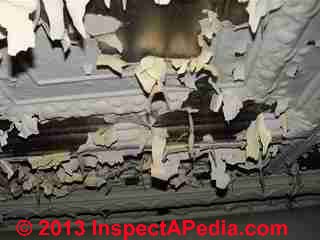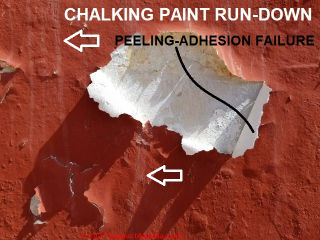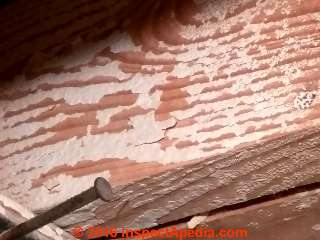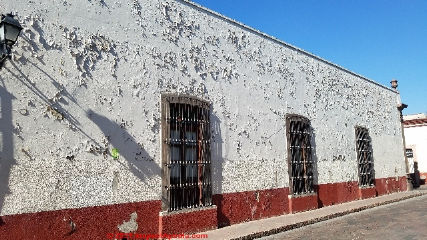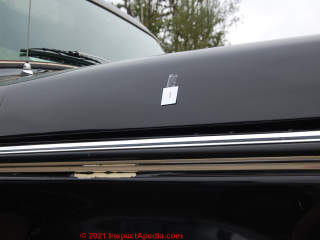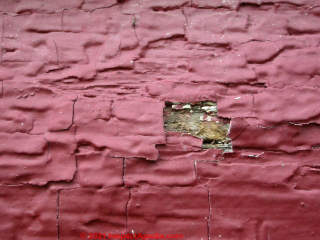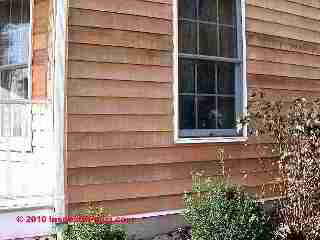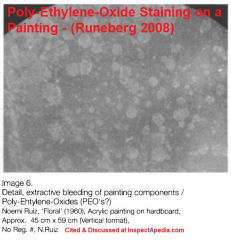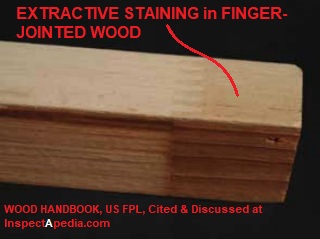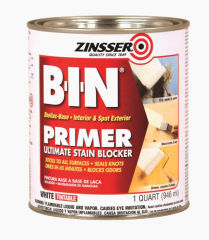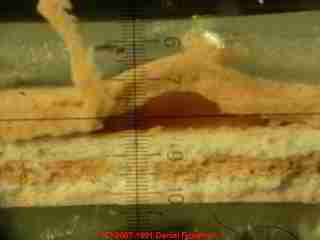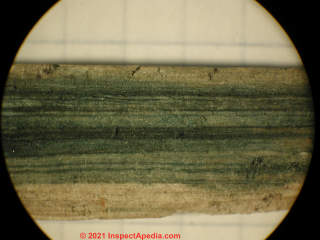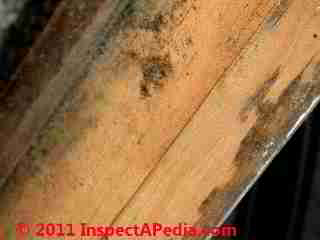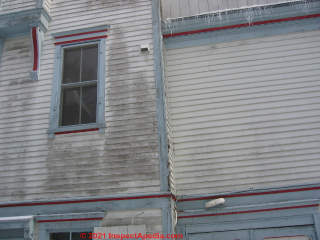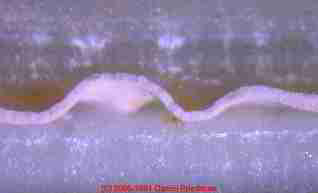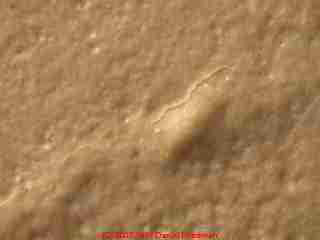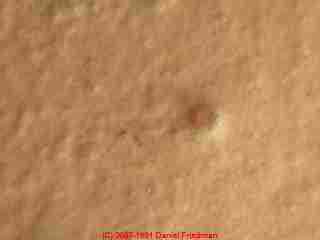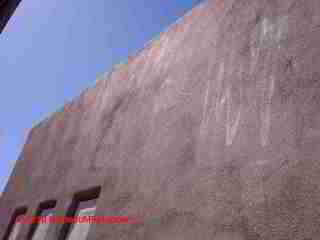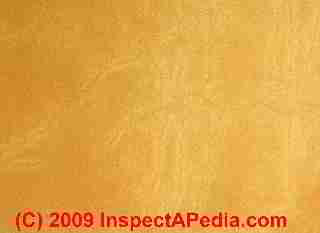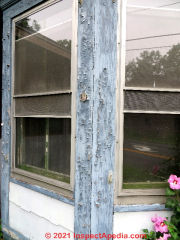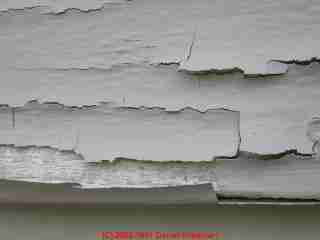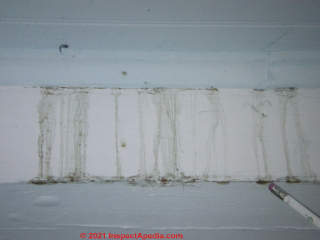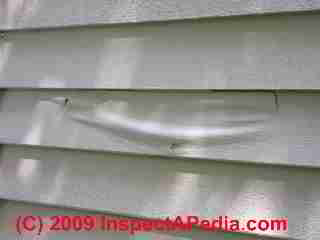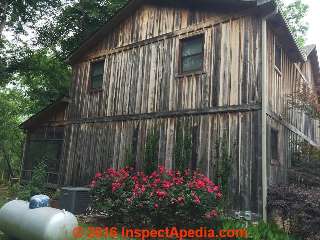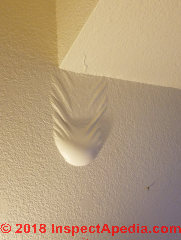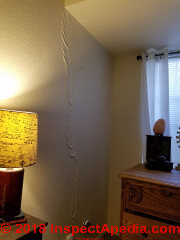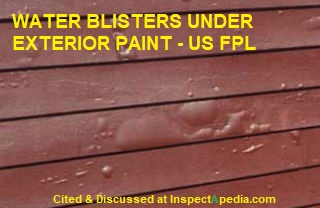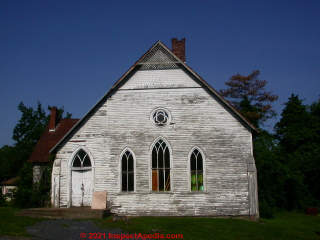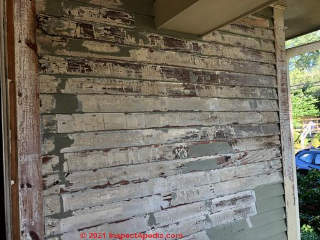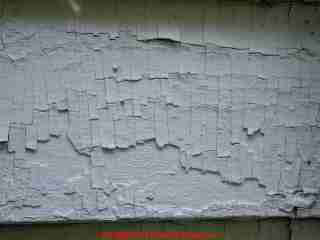 Pictorial Dictionary of Types of & Causes of Paint Failure
Pictorial Dictionary of Types of & Causes of Paint Failure
- POST a QUESTION or COMMENT about this article topic.
Paint failure & paint problem dictionary:
Here we provide an illustrated dictionary of types of paint failures and painting terminology. We show what different types of paint failures and painting mistakes look like on buildings and we define the terms used to explain kinds of paint job failures.
"Adhesion to Water Blisters" - A Dictionary & Photographs of Types of Paint Failures, Painting Terms, Paint Analysis Terminology.
What are the most common painting mistakes that we should avoid when painting a building?. How to diagnose the cause of failing paint on a building exterior or interior. Paint failure diagnosis checklists for the building exterior & interior.
This article series reviews common building exterior & interior painting mistakes, describes how to diagnose paint failures on buildings and in art conservation. We outlines a procedure for diagnostic field inspection & lab testing of failed painted surfaces on buildings.
We include photographs of paint failures on buildings and more photos of forensic paint laboratory examination of samples of failed paint useful to assist in diagnosing the probable cause of each type of paint failure.
We also provide a more comprehensive INDEX to RELATED ARTICLES for this topic, or you can try the page top or bottom SEARCH BOX as a quick way to find information you need.
InspectAPedia tolerates no conflicts of interest. We have no relationship with advertisers, products, or services discussed at this website.
- Daniel Friedman, Publisher/Editor/Author - See WHO ARE WE?
Encyclopedia of Paint Failures: Types of Paint Failures & Paint Failure Terminology
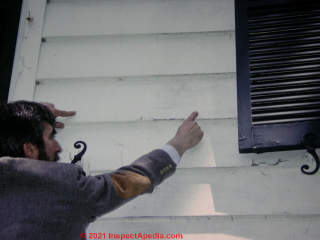 Since no single art, building or other paint failure reference enumerates all paint failure types for all types of paints, surfaces and applications on earth, the list which follows is a collection of the types of paint failures that occur on buildings and building surfaces, including most of the materials used in or on buildings.
Since no single art, building or other paint failure reference enumerates all paint failure types for all types of paints, surfaces and applications on earth, the list which follows is a collection of the types of paint failures that occur on buildings and building surfaces, including most of the materials used in or on buildings.
This paint failure list based on the author's field experience with house painting and paint failure investigations since 1978, supplemented with forensic laboratory analysis of failed paint since 1986 and influenced by the paint failure expert citations given at REFERENCES.
Photo: the author [DF] as a much younger fellow, pointing out paint wear and water leaks out of clapboard siding on a New York home.
[Click to enlarge any image]
Other information and paint failure suggestion sources are provided at Technical Reviewers & References.
Article Contents
- PAINT FAILURE DICTIONARY
- ADHESION FAILURE of PAINT
- ALLIGATORING PAINT FAILURE
- BLEED-THROUGH / EXTRACTIVE BLEEDING STAINS
- BLISTERING PAINT FAILURES - solvent blisters, thermal blisters, water blisters
- BLOOMING PAINT FAILURE
- BLUE STAIN / SAPSTAIN / BLACK MOLD STAINS
- CHALKING PAINT WEAR
- CHALK RUNDOWN PROBLEMS
- CRACKING PAINT FAILURES
- CHIPPING PAINT FAILURES
- COVERAGE FAILURES in PAINT
- DIRT CONTAMINATION in/on PAINT
- EFFLORESCENCE PROBLEMS in PAINT
- FADING PROBLEMS in PAINT
- FROSTING PROBLEMS in PAINT
- GALVANIZED SURFACE PAINT PROBLEMS
- GHOSTING PROBLEMS in PAINT
- GLOSS LOSS in PAINT
- HATBANDING PAINT PROBLEMS
- INCOMPATIBLE PAINT FAILURES
- IRON STAINING
- WAX BLEEDING on HARDBOARD PRODUCTS
- MASONRY PAINT FAILURES
- MILDEW PROBLEMS on PAINT
- MILLGLOSS PAINT FAILURES
- MIXING PROBLEMS in PAINT
- OVERLAPPING PAINT PROBLEMS
- PEELING PAINT FAILURES
- REHOLOGICAL FAILURES in PAINT
- RESIN FAILURES in PAINT
- RUN-DOWN STAINS
- RUST & CORROSION STAINS in PAINT
- SAGGING PROBLEMS in PAINT
- SKIMCOAT PAINT FAILURES
- SPALLING FAILURES UNDER PAINT
- SPOTTING FAILURES in PAINT
- STAIN BLEED-THROUGH PAINT
- SURFACTANT LEACHING in PAINT
- TACKY or SLOW DRYING PAINT
- THICKNESS DEFECTS in PAINT
- THINNER SOLVENT PAINT FAILURES
- VINYL SURFACE PAINT FAILURES
- WEATHERING of PAINT
- WRINKLING PAINT FAILURES
- YELLOWING PAINT PROBLEMS
- WATER BLISTERS in PAINT
Paint Adhesion loss - paint adhesion loss means the paint "lets go" of the surface onto which it was applied.
This is usually due to poor surface preparation, application of primer or paint on oily, dirty, chalky, or dusty surfaces, or painting over a glossy surface [on glossy paint or on mill-glazed siding].
Shown above is a paint adhesion failure on a pressed tin metal ceiling following an extensive water leak from above. Details are
at METAL CEILINGS ALUMINUM & TIN
Shown below is a paint adhesion failure between layers of paint on a building in Campeche, Mexico.
Because we also see white chalky streaks running down the surface of the ochre-colored and peeling top-coat, I suspect that the paint was applied over a chalked surface without adequate surface cleaning and preparation.
Paint adhesion failure due to use of incompatible paints: Paint adhesion loss may also occur if incompatible paints are used.
Fatty acids to migrate through acrylic paint (and other) layers. This phenomenon even can be observed in oil paintings, as some pigments require and absorb more linseed oil than others. People in the art world know that one of the basic rules in applying painting is: always fatty on top of lean (highly bound on less bound media).
Paint adhesion failure due to gravity? One paint manufacturer's rep told our client that the paint was falling off of the house due to an "adhesion loss due to normal aging and gravity - a view which we consider nonsense.
Gravity is not a significant factor in paint failure though once a paint chip has totally separated from a building surface, indeed it is the force of gravity which brings it away from the building and to a nearby horizontal surface or to the ground.
If the adhesion principal failure were only "normal aging" then the paint should be failing uniformly wherever it was applied.
Of course weather, including rain and sun exposure are indeed critical factors in paint wear and failure, and these forces are not uniform over surfaces at a building.
Above: many layers of paint have accumulated on the George Brinkerhoff house built in the 1700s. Historians assert that George Washignton slept in this home on his march to Connecticut in 1776. Portions of this home date from 1759.
Also see PEELING PAINT FAILURES
Above: paint adhesion failiure on a building in Guanajuato, Mexico. A paint adhesion failiure such as this one may be caused by over-thinning of the paint to make it "easier to apply" as the painter told us.
Paint adhesion failures or paint cracking on stucco surfaces due to improper application or water exposure -
Below: automotive paint adhesion failure on a Ford pickup truck, courtesy of an InspectApedia reader
We suspect that the vehicle was painted over an area of metal that had a bit of oil or petroleum-based solvent still on the surface.
Alligatoring: [very common failure] cracked paint which resembles alligator skin. This is due to application of paint in too many layers. The inner paint layers have lost elasticity. As temperatures change and the building surfaces expand and contract, the old, brittle paint cracks.
Alligatoring might also be caused by poor adhesion to a glossy surface, painting over an inadequately-dried first coat, or from weather exposure.
Painting over an "alligatored" surface is futile. The older under-paint will continue
to crack, causing failure of the new coating. Stripping off of the old paint down to bare wood is what's needed.
Also see CRACKING PAINT below for a distinction between these two similar failures.
Below: Alligatored paint on a log cabin fails when the painter simply blobs more paint on an already-failing painted surface.
Paint Bleeding, extractive bleeding, or paint bleed-through stains: these terms describe any painted-surface discoloration caused by the combination of solvents in paint with solvent-soluble dyes, debris, or organic substances in or on the painted surface.
Solvents in the paint dissolve an ingredient in the painted surface, bringing it through the layer of paint, showing up as a discoloration or stain on the finished surface. Below: bleed-through staining on a building wall.
Photo: extractive bleeding stains on wood clapboards.
Bleed-through stains on painted surfaces can show up as streaks, splotches, round or oval stains, or whole areas of discoloration, depending on the source of the stain substance and the type of paint applied to the surface.
[Click to enlarge any image]
There are several types of paint bleed-through stains:
- Extractive bleeding paint staining: in the most-general case, solvents in paint dissolve ingredients in or contaminants on the painted surface, causing the dissolved ingredient or solvent to migrate up through the paint layer to appear on the dried, painted surface.
Details of tannin extraction and stains on building exteriors are
at EXTRACTIVE BLEEDING SIDING STAINS
Also see STAINS on RED CEDAR SIDING
- Extractive bleeding stains on artwork painting surfaces or painting mounting boards, backers, or materials have been described by Runeberg and others as sometimes traced to Poly-ethylene-oxides. [Image above]
Runeberg, Ulrik, STAINING AND MICROBIOLOGICAL INFESTATION OF ACRYLIC PAINTINGS ON HARDBOARD [PDF] (2008), Ulrik Runeberg, Conservator (Dipl. Rest./M.A.), Restaurierungszentrum der Landeshauptstadt Düsseldorf, Germany, Email: Rune-Ulrik@gmx.de Previously Museo de Arte Contemporáneo de Puerto Rico, San Juan Presented, April 2007 conference in Richmond Virginia, sponsored by the AIC (American Institute for Conservation), this paper discusses the staining and microbial infestation of acrylic paintings on hardboard. - private correspondence, ER <->DF 2020/01/05 - 2006/09/12.
On superficial examination at only low magnifications, microbiological deterioration of art works, such as due to fungal attack, can be confused with other causes of spots, blotching, or staining in works of art, such as extractive bleeding from pressed hardboard substrates. - source: where we discuss
at HARDBOARD & MASONITE USED in WORKS OF ART
Also see ARTWORK MOLD CONTAMINATION - mold on paintings or other works of art - Moisture & contaminant bleed-through shows up as stains on stuccoed surfaces.
See PAINT on STUCCO, FAILURE - Preservative oil bleeding, appearing on painted, preservative-treated wood
With oil-type preservatives, preservative bleeding or oozing out of the treated wood is a particular concern. This problem may be apparent immediately after treatment.
Such members should not be used in bridges over water or other aquatic applications. In other cases, the problem may not become obvious until after the product has been exposed to heating by direct sunlight. This problem can be minimized by using treatment practices that remove excess preservative from the wood. - (Wood Handbook US FPL (2010) p 15-23)
- Run-down extractive bleeding stains appear on the surface of painted or stain-treated clapboards whose back surface was not primed.
See details at RUN-DOWN STAINS - Rust and debris bleed through shows up on the finished, painted surface; iron oxides appear as red-brown stains showing through a painted-over surface;
see RUSTING - Dirt, debris, tannins, or other water soluble or solvent-soluble dye bleed-through; contaminants or ingredients located in or on the painted surface such as may occur in some fiberboard or hardboard products
- Wax bleed-through: water-based or organic solvents in the paint dissolve and bring to the painted surface chemicals, dyes, or substances on hardboard siding from wax in the siding.
See also FIBERBOARD SHEATHING INGREDIENTS
We often see this cosmetic defect when paint is applied over cedar siding as well; - Wood extractive oils, paint solvent soluble, brought to the painted surface by organic solvents in oil and acrylic and even latex paints.
Wood also contains resins and oils that are insoluble in water. The type and amount of these compounds in lumber depend on the wood species.
For example, many pines contain pitch and the knots of almost all wood species contain sufficient oils and resins to cause discoloration of light colored paint. Since these oils and resins are organic in nature, they are similar chemically to oil-based and/or alkyd paints; therefore, they cannot be blocked by typical oil borne stain-blocking primers as can the water-soluble extractives. Latex-based formulations are also ineffective.
Knots can be sealed prior to priming with shellac or similar finishes specifically formulated to block oils and resins. Because shellac is sensitive to moisture, it is essential to use it only over the knots and to seal it into the knots with a good paint system. In many species, bleeding of oils and resins from knots is a difficult problem. At present, there is no easy fix other than the extra step of sealing knots before priming.- (Williams 1999)
- Wood extractives, water soluble, brought to the painted surface by water-solubles in paints, particularly from heartwood or from knots.
Wood extractives are highly-colored, usually brown or tan, extractives found in the heartwood of softwoods such as western red cedar, redwood, as well as hardwoods such as walnut and mahogany. These extractives may be brought to the surface of paint by water solvents in the paint or they may appear later by rain or other water that penetrates the painted surface.
Water-soluble colored extractives occur naturally in the heartwood of such species as western red cedar, cypress, and redwood. These substances give the heartwood of some species their attractive color, water repellency, and natural decay resistance. However, discoloration of paint may occur when the extractives are dissolved and leached from the wood by water.
The water carries the extractives to the painted surface, then evaporates, leaving the extractives as a yellow to reddish brown stain on the paint. The water that gets behind the paint and causes moisture blisters also causes migration of extractives. - (Williams 1999)
Research on Paint Bleed-Through & Extractive Bleeding Stain Cause & Prevention
- Burke, Edward, Norm Slavik, Tony Bonura, Dennis Connelly, Tom Faris, Arnie Nebelsick, Brent Stuart, Sam Williams, and Alex C. Wiedenhoeft. "Understanding extractive bleed: wood extractives: distribution, properties, and classes." CoatingsTech. Vol. 7, no. 3 (Mar. 2010): p. 48-53. 7, no. 3 (2010): 48-53.
- Van De Mark, Michael R., Kathryn D. Sandefur, and Katherine A. Durham. "Paint." Kirk‐Othmer Encyclopedia of Chemical Technology (2000).
- Williams, R.Sam, FINISHING of WOOD [PDF], R. Sam Williams, US Forest Products Laboratory, (1999) in Wood handbook : wood as an engineering material. Madison, WI : USDA Forest Service, Forest Products Laboratory, 1999. General technical report FPL ; GTR-113: Pages 15.1-15.37
- Wood, Treated. "Application of Finishes, Special Uses." in WOOD HANDBOOK [PDF] U.S. Forest Products Laboratory, (2010) retrieved 2021/06/19 original source: https://www.fpl.fs.fed.us/documnts/fplgtr/fpl_gtr190.pdf
- Also see PAINT FALURE, DIAGNOSIS, CURE, PREVENTION
Question: what caused the oval brown stain on our new sign?
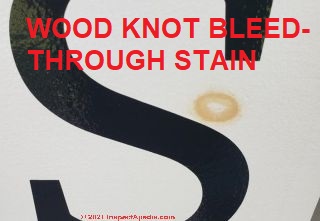 I put white exterior paint on a welcome board. Why is this happening? - Anonymous, 2021/06/19
I put white exterior paint on a welcome board. Why is this happening? - Anonymous, 2021/06/19
Photo: the tan ovate stain in the photo above is probably a pine knot whose tan extract, dissolved by solvents in the paint, has bled through to show up on the dried, painted surface. [Click to enlarge any image] - courtesy of an InspectApedia reader.
This Q&A were posted originally
at STAIN DIAGNOSIS on BUILDING EXTERIORS
Moderator reply:
With no contextual information I can but guess that you painted on a plywood or pine board surface that contained a knot that caused a brown-tan bleed-through.
Many paints contain solvents that will dissolve pine tar in wood knots causing it to cause the tan marks such as that shown in your photo.
The solution is to first seal the knot with a lacquer primer-sealer like Bin or Enamelac then apply your finish paint.
You can still do that.
Paint Blistering: this very common failure is caused by moisture getting behind paint, or by painting over wet or damp surfaces.
In this dictionary we describe the various types of blistering that occur in paint jobs:
Moisture blisters in paint usually occur when moisture evaporates to form a vapor bubble under an impermeable layer of paint, especially on new thin coatings or oil paint coatings.
The small paint blister examined under our lab microscope (above) is discussed in detail at
PAINT FALURE, DIAGNOSIS, CURE, PREVENTION
Paint & Wood Blue Stain, Stapstain, or Mold Stains appear as black, blue, dark green and blue-green stains on wood surfaces. While fungal staining and sapstains are principally observed on un-finished wood, painting-over fungal stains or fungal infections can result in a bleed-through type staining on the finished surface. Other colours may also appear as we'll explain.
Photo above: photographed in our forensic lab, the fungal-based blue-green stain in this wood scrap is in a sample collected along the Appalachian Trail in Dutchess County, New York in 2021.
According to the US FPL,
Blue stain is a fungus that can infect sapwood of trees and logs (Fig. 16–27). Insects, such as the pine beetle, may carry it into a living tree.
Pine beetle infestation often disrupts the flow of nutrients, thus killing the tree. Sapwood of lumber from beetle-killed trees usually contains blue stain. Blue stain may also infect logs after harvest while the MC is still high.
The fungus causes a blue discoloration of the wood, but the organism does not weaken wood structurally. The fungus lacks the enzymes necessary to digest wood polymers; it lives off the unpolymerized sugars in the sapwood (see Chap. 14). Neither commercial mildew cleaners nor household bleach with detergent can remove it.
If the color is objectionable, use a pigmented finish to hide it ... (Wood Handbook, U.S. FPL p. `6-30)
Similarly, other fungal attacks on wood produce stains of various colours, particularly black, green, and red. Some of these are considered only of cosmetic import while others, if found on indoor wood, may be a health hazard.
See details BLACK MOLD, HARMLESS
Also see
- BLEED-THROUGH / EXTRACTIVE BLEEDING STAINS
- PHOTOS OF MOLD ON WOOD SURFACES
- WOOD FRAMING & PLYWOOD MOLD CLEANUP
Below: dark mold and/or algae staining on an abaondoned building in New York.
The dark growth patterns map the more-wet surface areas.
Thermal blistering, or "temperature blistering" occurs when painting in sun, or if paint is applied to hot surfaces; the blister may be from moisture or solvents in the paint itself, when its outer skin dries before its inner layers, and the inner layer is heated.
Both causes may occur together. Thermal blistering or paint solvent blisters look very different in the paint film from moisture-caused blistering.
The microphotograph shown here at 120x, taken in our laboratory, shows the edge of a microscopic paint blister, possibly solvent or thermal blistering.
Often one cannot see this defect with the naked eye. Instead one observes paint cracking and adhesion failures on the painted surface. Microscopic laboratory analysis is required to complete the failure diagnosis.
See our separate article on
PAINT LAB SAMPLE PREPARATION for a procedure useful to prepare an edge-view of paint layers for microscopic examination.
Also see NCR133 article below.
Also see WATER BLISTERS in PAINT
Paint Solvent blisters are small, usually microscopic. Where solvent blisters rupture they may leave pinholes in the paint or small craters. Usually ruptured solvent blisters leave craters surrounded by fine cracks radiating out from the crater.
Distinguishing solvent blisters from small moisture blisters:
Paint Solvent blisters occur as the paint is drying as solvent trapped behind the drying or dried outer film of the paint layer form gases (perhaps from sun exposure) which form a bubble and try to escape from the film.Paint Moisture blisters may be small, tend to occur behind the paint film after the paint is totally dry, are round or
have rounded edges,
separate the paint from the old surface uniformly, may bleed water when punctured, and can on occasion be
extremely large, as much as 24" x the width of a clapboard.
Moisture blisters in paint do not create pinholes, craters, nor crater-cracks.
Like thermal blisters, solvent blisters may be an underlying mechanism for paint failure that cannot be seen by the naked eye.
Where paint cracks around pinholes and blisters, paint adhesion failure may be observed.
See also WATER BLISTERS in PAINT for examples of very large paint blisters due to water leaks in a building.
The ultimate paint failure, loss of paint adhesion,
may be due to paint shrinkage and movement over the surface or moisture penetration of the paint layers at pinholes and cracks.
Paint which has failed in this manner may show other mechanisms of paint failure as well, such as separation of paint ingredients
such
as SEPARATION & BUBBLING of PAINT RESINS intended to function as adhesives, also key factors in the paint loss from the surface.
These details become more apparent in the laboratory under forensic microscopic examination of samples of failing paint.
Also see INCOMPATIBLE PAINTS
Paint Blooming - (blushing) - this is moisture getting into varnish, shellac, lacquer.
This coating failure leaves a milky opaque (usually-white) cloud on (or actually within) the coated surface.
Paint bloom may not wipe off with a fingertip as does most efflorescence - so paint blooming is not the same visual effect as surface efflorescence, though many paint failure analysts use "bloom" for both cases and although the cause might be the same - moisture.
See PAINT on STUCCO, FAILURES and
see EFFLORESCENCE PAINT BLOOMS below for an example of white bloom of efflorescence on a painted stucco exterior.
Above: this peeling paint on stucco on a building in Guanajuato also shows white streaks as chalking white paint bursts through the "new and peeling" paint job to run down the wall.
Paint Chalking - [common condition] weathered powdery exterior painted surfaces, may be normal, or may be premature if paint was excessively thinned or inadequately primed.
Painting over a chalky surface means that the new paint will not adhere to the surface itself - since the oxidized "chalky" paint particles of the older coating interfere.
Paint Chalk run-down - [common condition] is caused by chalking paint which runs down and stains other wall areas or masonry or foundations below. This cosmetic defect is most noticeable on an un-painted masonry wall below a painted surface such as a window, or wood siding above a brick wall.
The oxidized paint which has washed onto the masonry surface can be mostly-removed by power washing, but don't damage brick masonry walls by using high pressure sand or water which can remove the glazed surface of the brick, leaving it vulnerable to future water and frost damage.
Paint Chipping: paint breaks away from the surface due to poor surface preparation or possibly due to mechanical damage; painting over chalked surfaces can also cause this defect. If the failure is due to painting over a chalked surface the paint chips will expose an older painted surface below.
f the failure is due to mechanical damage (such as a lawn-mower kicked-up stone), usually the chip exposes bare wood below.
Paint Coverage: failure to cover or hide - usually due to poor paint mixing or poor color choice, such as trying to paint a light color over a dark surface in a single coat.
Paint Cracking, Checking, Flaking, or Crazing - paint loses its elasticity, crazes, then cracks, especially where paint is thick or multi-layered. Also see "alligatoring" above. Cracks occur when paint is applied too thickly on the surface, or possibly when multiple layers of paint are present.
Often the inner (older) layers of paint have lost elasticity and have already cracked, or form cracks which telegraph through the newer outer layer. Painting over such surfaces is likely to lead to failure as moisture invades the surface at cracks.
This means that moisture gets behind the paint on the surface, thus
eventually leading to paint failure. The distinction we make between "alligatoring" and "cracking" is this:
"cracking" produces long, variegated and usually fairly thin openings in a painted surface. Cracking may occur
even in a thinly painted surface.
"Alligatoring paint failure" has a distinctive pattern in which the paint fissures form
a rectangular pattern, each rectangle being perhaps less than 1/4" square, and always in thick old paint. (Beware of
lead paint hazards when stripping old painted surfaces.
For diagnosing hairline cracks in painted stucco, also See STUCCO PAINT FAILURES.
Advice from the US FPL:
Paint Cracking Parallel to Wood grain: Cracking parallel to grain occurs on smooth flat-grain lumber, particularly with wood species having abrupt transition
between EW and LW bands (such as southern yellow pine,
Douglas-fir, and oak). LW bands are compressed into EW
during planing.
Normal rebound of LW bands after wood is
in service causes films to crack along the EW–LW boundary.
Other contributing factors are coatings having insufficient thickness and lacking flexibility. If the cracking is not
too severe, scuff sand and apply one or two top-coats to give
additional film-build. - (US FPL Wood Handbook p. 16-25)
Paint Cracking, Across the Wood Grain: Modern waterborne latex finishes seldom fail by cross-grain
cracking.
If latex finishes crack across the grain, dimensional instability of wood under the finish causes it. For example, cross-grain checking of juvenile wood causes paint
to crack.
In this case, replace the board and repaint.
If juvenile wood is not to blame, cross-grain cracking usually occurs on structures having thick layers of oil-alkyd
paint.
If the wood is not the cause of paint failure, remove
the old paint and apply new finish to the bare wood. Old
paint probably contains lead (see Lead-Based Paint). - (US FPL Wood Handbook p. 16-26)
Paint Dirt pick-up: dirt adheres abnormally to painted surfaces. Excluding dirt that collects on upper portions of exterior siding, e.g. from road and traffic dust [where roof eaves prevent rain from washing off this dirt] or from rain splash-up at ground level, paint may be tacky from improper solvents, paint incompatibility, or if the surface is indoors, inadequate drying ventilation.
Efflorescence and mottling on painted surfaces.
Efflorescence is a white or yellowish [usually mineral]
salt formed on masonry or plaster due to moisture migrating through the surface, evaporating, leaving mineral crystals
behind. Efflorescence is hygroscopic, and by attracting more moisture, will continue to accumulate.
For some detailed
photos of efflorescence (sometimes mistaken for "mold")
see EFFLORESCENCE & WHITE OR BROWN DEPOSITS.
Our photo (left) shows white efflorescence and mottling that appeared on a painted exterior new-stucco wall of a home in the Southwestern U.S. after less than a year of application.
See PAINT on STUCCO, FAILURES for details of stucco paint problem diagnosis & avoidance.
Painting over open cracks where moisture has not fully evaporated or painting over new too soon and where the stucco surface pH or alkalinity remains too high (over 11) invites cosmetic problems as well as early wear or failure of the painted coating.
The application and curing procedure used for stucco, in turn affect the wall pH - it needs to be tested by the painter before the paint job begins.
Also see PAINT BLOOMING.
Above: blue exterior trim paint has faded nearly white and is now peeling on this home in Hugsonville, New York.
Paint Fading - this is natural paint weathering due to the ultraviolet light (in sunlight); interior paints used on exterior surfaces may fade quickly [and are probably less weather resistant in general]. Often fading is accompanied by chalking.
Loss of gloss and fading typically occurred with traditional oil-alkyd finishes.
Although modern acrylic-based latex finishes do not give the high gloss of an oil-alkyd, they maintain gloss much longer.
Some pigments fade more than others; check with the paint manufacturer to ensure that the colors will last. White is always a safe choice. The paint and solid-color service-life estimates given in Tables 16–4 and 16–5 do not take into account loss of gloss and fading.
Many dark-colored finishes will fade to give unacceptable [aesthetic or cosmetic ] performance long before the finish fails. - (US FPL Wood Handbook p. 16-29)
Other color changes in paint beyond fading and oxidation are discussed by forensic and restoration experts.
More help is at
- Cassens, Daniel L., Feist, William C., DISCOLORATION OF HOUSE PAINT-CAUSES AND CURES [PDF] US FPL, USDA et als, under Wood Finishing, North Central Regional ExtensionPub. 134, Extension Service, U.S. Department of Agriculture, Washington, D.C
Excerpt:
Under normal conditions paint deteriorates by first soiling or by a slight accumulation of dirt. Next, a flattening stage develoops when the coating gradually starts to chalk and erode away. Unfortunately, paint is sometimes discolored by mildew, blue stain, wood extractives and metals long before repainting is necessary. In these cases, a simple repainting will not correct the problem for long.
Furthermore, excessive painting is expensive,and a build-up of paint on the wood surface may lead to cross-grain cracking or other severe paint failures. If the old paint surface is not properly cleaned before repainting, inter coat peeling may also result.
Paint Frosting - I associate this defect with a matte finish on paint that is supposed to give a smooth surface, possibly from chemical incompatibility with the existing coating on the surface.
Galvanized metal paint failure - poor adhesion to galvanized metal- paint peels or pits when painted on galvanized steel.
Causes of paint failures on galvanized metal surfaces:
- Painting with wrong paint: alkyd/oil based paints lose adhesion when painted on galvanized metal surfaces and therefore fail quickly.
Some sources claim that using an alkyd paint on a galvanized surface will cause paint saponification failures. See an explanation of paint saponification at
STUCCO PAINT SAPONIFICATION & ADHESION FAILURES - Painting over new galvanized metal or on rusty galvanized metal that has
not been cleaned.
It is prevented by "curing" the galvanized metal before painting it. One approach is to let (outdoor) galvanized steel simply weather for a year.
Some painters will etch the surface of the galvanized steel by washing it with a dilute acid such as vinegar. If you are using a de-greasing cleaner be sure it is water based.
Watch out: Be sure that the etched galvanized metal surface is washed clean of the acid and that it is completely dry and clean before painting.
Beware that heating or oxidizing galvanized steel can release toxic gases. - http://www.ppg.com [original source page no longer maintained by PPG]
Watch out: surface preparation of the galvanized metal by use of a mild acid or wash is probably a better approach than allowing the surface to weather, because weathering of a galvanized metal surface will eventually produce coating of oxidized zinc, appearing as a white dust or powder, that in turn may prevent good adhesion of the paint to the metal. - Painting on new, oily-surfaced galvanized metal, especially at low temperatures, is likely to cause poor paint adhesion and an early paint failure
- Painting on galvanized surfaces cleaned with an oil-based solvent such as turpentine leaves an oil film that may cause poor paint adhesion.
- Painting over rusted galvanized surfaces that are not first adequately sanded or wire-brushed will cause early paint failure
Paint Ghosting - this is caused by improper surface-priming, perhaps by too-thin application of the primer: walls are not absorbing paint uniformly.
When the author was painting homes we avoided this issue by applying primer uniformly and not spreading it too thin, and if ghosting was visible in the primer coat we added a second primer coating.
An assistant who tired to "stretch" the paint too far, thinking he was economizing, created such bad ghosting on one project that we had to paint an entire interior over again. It would have been much cheaper not to have spread the paint so thinly in the first place. We also see a similar defect if a paint roller is too dry when applying paint over a surface.
Paint Gloss - loss of: this is due to improper priming where old paint was removed; high surface porosity also causes loss of gloss as does paint applied in damp or foggy weather. A glossy paint will be low-gloss or nearly flat if the paint was over-thinned.
http://www.ppg.com/getpaint/etraining/solver/e_gloss.html cites painting in sun, using interior paint outside, or poor quality paint as causes for loss of gloss.
Paint Hatbanding or "Lapping"- is caused by thick paint applied at multiple layers where cutting in `(usually) of interior walls, ceilings , and corners, or use of excessively long roller naps. We see this quite often where a ceiling or wall corner is cut-in to the rest of the painted field using a brush, and then the field of the painted area is covered using a roller.
Lapping or hatbanding marks in paint jobs is a cosmetic defect.
Hardboard siding staining or "wax bleed" is cited by Lowes and PPG, and refers to waxes in composite siding [such as "Masonite (TM)" hardboard which bleeds (usually a brown stain) to the surface if a proper surface sealant was not used as a primer.
Such stains may be mistaken for mold.
See http://www.lowes.com/lowes/lkn?action=howTo&p=Improve/WaxBleed.html&rn=RightNavFiles/rightNavPaint
Paint Iron Staining occurs when iron or ferrous oxide produces a reddish-brown stain on wood or on its painted surface as a metal object rusts or as the surface of a metal object, such as a nail or screw or fixture on or in the wood is oxidized by a chemical reaction with tannins in the wood itself. The presence of water or moisture is, of course key to iron stains on wood.
Iron stains occur from rusting of fasteners or by the reaction of iron with tannins in wood. The appearance is different for each of these reactions. In wood species that lack tannins, iron merely rusts, giving a brown stain to the wood surrounding the fastener. The iron also causes slight degradation of the wood near it (often referred to as “wood sickness”).
This discoloration develops over many months or years of exposure. In those wood species that have tannins, a chemical reaction takes place between the iron and the tannins. Tannins are just one of the many chemicals (extractives) in wood. Species such as the cedars, the oaks, and redwood are rich in tannins. Iron reacts immediately with the tannins to give a blue-black discoloration. - (US FPL Wood Handbook p. 16-30)
Masonry paint failure: Poor alkali resistance - this refers to color loss and paint deterioration on masonry, possibly caused by painting over new masonry such as a recent pour of concrete.
- Pittsburgh Paint Corporation's information on masonry paint failures and alkali resistance at http://www.ppg.com/getpaint/etraining/solver/e_alkali.html.
Also see EFFLORESCENCE marks & stains in or on paint.
Mildew [Mold]: dark or colored spots or shading in paint caused by mold growth, particularly in damp or shaded areas. Molds which are misnamed as "mildews" in this case are growing on nutrients in paint, varnish, or on organic debris on the coated surface.
Some coatings such as oils and linseed oil-based paints are particularly mold-friendly.
Many modern paints contain "mildewcide" to reduce this effect or it can be added [beware it's probably a serious toxin.] Mildew is indeed a type of mold, but it grows only on living plants.
Acrylic latex paints are more mildew resistant. Good surface prep is important. Actually real "mildew" will never be found on painted surfaces. Mildew will be a member of one two groups, "Downy" or "Powdery" but in any case mildew is an obligate parasite which grows only on living plants.
What people call "mildew" on painted surfaces is mold. Unless your walls are covered with grapes, its not "mildew."
Not that that's much consolation. In some cases other small black spots on a wall might have been put there by "artillery fungus" a mold genera which shoots small black sticky spores onto a surface from its nearby point of growth. In this case the paint is not at all at fault.
Finally, small black spots may appear on a painted surface where vines have been removed and where the vines' attachment points pulled off paint or left organic debris behind when the vines were removed. A close look is needed to distinguish these patterns on a wall.
Artillery fungus spots are likely to be close to the ground-only. Vine spots and damage will follow a vine-growth pattern up the wall from the ground. Mold growing on a painted surface is often keyed to areas of shade and moisture exposure.
To properly prepare to paint a moldy or mildewed surface you need to remove the mold and correct the reason it grew there in the first place.
See MOLD CLEANUP GUIDE- HOW TO GET RID OF MOLD
To cover and seal mold-stained surfaces after that cleaning,
see FUNGICIDAL SEALANT USE GUIDE
For an analysis of the effects of mold contamination on the paint in artworks
See ARTWORK MOLD CONTAMINATION
Mill gloss on painted surfaces is a hard shiny surface left on wood clapboards or wood trim as a result of the lumber milling process. A high-speed rotating planer or cutting blade which is used to impart a flat smooth finish to (usually one) side of a wood clapboard, or to interior wood trim can leave the surface of the wood hard and shiny.
Unless this "gloss" is broken by light sanding there is risk of poor paint or stain penetration of the wood surface and thus a failure of the coating to adhere to the surface of the wood. -- DJF.
Mixing problems in paint causing paint failures: failure to properly disperse pigment, binder and solvent agents in paint can cause early paint job failures that show up as poor coverage over existing colors or stains, poor adhesion of paint to the surface, and uneven paint jobs. Over-thinning or over-extending a paint with solvent can cause similar failures.
Also see THINNER SOLVENT PAINT FAILURES
Nail head rusting under paint - occurs where nails on a surface are painted over, usually with a water-based paint, which rusts the nail head. It can be prevented by setting and puttying over old rusty nails, by sealing nail heads with a lacquer-primer before painting the surface, or by using stainless or galvanized nails in the first place.
Even galvanized nails may rust, however, if the impact of the hammer cracks the galvanized coating on the nail.
Overlapping Paint - see HATBANDING or LAPPING PAINT MARKS above. This also occurs on exterior or interior surfaces where paint is allowed to dry and then newly-applied paint overlaps the dried section as the next area is painted.
When the author was painting houses we reduced this hazard (particularly indoors) by rolling out an increasingly thin coat at the edge of a section which we know is likely to dry before getting back to continue with new paint. Using a paint roller that is very wet for the last edge of a section is likely to leave a ridge of thick paint that will show overlapping when painting continues.
Paint incompatibility - may be a cause of peeling, blistering, wrinkling, or other
failures. Be sure to read the manufacturer's label and to either determine what paint is already on a surface to be
re-painted, or review your choices with a paint expert. Also
see THINNER SOLVENT PAINT FAILURES - don't use the wrong type of thinner in your paint.
Paint Peeling - strips or sections of paint peel loose from the surface, usually due to moisture and/or inadequate surface preparation.
Peeling paint may be failing at the juncture of paint to the wood (or other material) surface, or peeling may occur between paint layers - intercoat peeling.
Some inspectors mix descriptions of "blistering" and "peeling" but since the causes and remedy differ the distinction can be important.
Paint-Surface Peeling
Help with Paint Peeling and Flaking from the US Forest Products Laboratory
Peeling and flaking (adhesion failure between wood and the primer) can have several causes: water, wood weathering, and dimensional change of thick LW bands on flat grain of high-density wood species. Flaking often follows cracking; small cracks in paint caused by raised grain allow water to enter.
Flaking is similar to peeling; small pieces of finish peel from the surface usually along an EW–LW boundary. Flaking often occurs with cracking parallel to grain and is attributed to thin films. It can occur with thinly applied filmforming finishes and with oil-based semitransparent stains if they do not absorb properly.
Water is the main cause, but other factors can also cause it. Water speeds the failure by other causes. One cause is weathering of wood prior to primer application. Protect wood from the weather prior to installation and paint it as soon as possible after installing it. Leaving smooth-planed lumber exposed to the weather for as little as 2 weeks decreases its paint-holding properties.
If wood was exposed
more than 2 weeks, scuff sand it prior to painting. In fact,
scuff sanding is always a good idea on planed lumber. The
wide bands of LW on flat-grain surfaces hold paint poorly.
If possible, flat-grain boards should be installed “bark-side”
out to minimize raised grain particularly with wood species
having abrupt EW/LW transition.
Paint applied to weathered
wood often fails over large areas and can be easily diagnosed by inspecting the back side of the peeled paint. Wood
fibers are attached to the film clearly showing the grain of
the wood. -
(US FPL Wood Handbook p. 16-26)
Intercoat Peeling Paint Failures
... intercoat peeling is loss of adhesion between coats of finish, usually peeling of a new paint from old paint (Fig. 16–23). It usually occurs within a year of repainting.
Prevent intercoat peeling by ensuring that old paint is free of dirt, mildew, and chalk prior to repainting.
Intercoat peeling can also result from allowing too much time between applying primer and top-coat. If more than 2 weeks elapse between applying an oil-based primer and a top-coat, clean the surface before applying the second coat.
If the primer (particularly oil-alkyd primers) has weathered for several months, it may be necessary to re-prime prior to applying the top-coats (see Testing for Adhesion). - (US FPL Wood Handbook p. 16-17)
OPINION: Intercoat-peeling paint failures are also common between incompatible paints.
We may see poor bonding between paint layers, or a solvent in the new paint layer can reduce binding between the paint layers; we also sometimes find that a solvent in the new paint layer causes a failiure between the older paint layer and the painted-on surface.
Paint Rheologogical Failures - paint rheology is the science of the flow of paints and coatings on or onto surfaces. Paint that drips, sags or cracks when it should not, all other application considerations being blameless, has suffered, in my opinion, a rheological failure.
A paint needs to be stable while the paint is in storage, liquid enough to be applied to a surface, and viscous enough that it doesn't run and sag down the coated surface (provided the paint is being applied properly with respect to thinning, temperature, humidity, etc.)
Paint experts discuss the shear stress of paint, shear strain, and shear rate, paint viscosity, shear thinning or shear thickening, a paint's thixotropic properties - how its viscosity varies over time, the visoleasticity of paint that affects its shelf life, and the "normal force" generated against shear stress in an applied paint coating.
Additives, even "microfibrillated cellulose" may be added to paints to adjust its rheology.
Special instruments measure the rheological properties of paints - beyond my expertise so I'll quit here. See Lambourne (1999) and see (Karlson 2000) in the REFERENCES section of this article.
Paint Run-Down Staining - is a form of extractive bleeding that occurs from the un-painted or un-primed back surface of wood siding.
Water penetrating the siding absorbs extractives from the wood that then appear as run-down stains on the exterior surface of painted or stain-finshed wood siding, particularly horizontal clapboards.
Water penetrating a clapboard wall can also dissolve dirt or even asphalt in building paper to produce other dark stains that appear at the top edge of a clapboard or at horizontal trim like that in our photo above.
How to prevent paint run-down stains on clapboards:
Back-priming
with stain-blocking primer retards extractives staining, particularly run-down extractives bleed. It decreases absorption
of water, thus improving dimensional stability. ... At the time siding is back-primed, seal end grain with oil alkyd primer. This process has an even greater effect in stopping water absorption than back-priming. - -
(Wood Handbook US FPL (2010) p 16-25)
Also see BLEED-THROUGH / EXTRACTIVE BLEEDING STAINS
Paint Rusting - painted metal surfaces such as nail heads show through the new paint, perhaps where metal is exposed to moisture from the paint itself if a water-based paint is used. Rust stains on buildings -
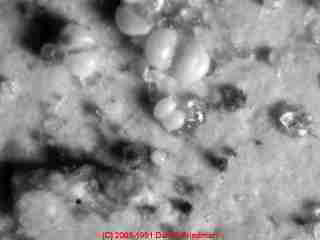 Paint Resin Failure - paint resins separate out from the paint mixture, perhaps due to
improper paint formulation, improper paint mixing, combining incompatible paints, or exposure to high temperatures
during drying.
Paint Resin Failure - paint resins separate out from the paint mixture, perhaps due to
improper paint formulation, improper paint mixing, combining incompatible paints, or exposure to high temperatures
during drying.
This defect is completely invisible on the painted surface and on failing paint chips, but it can be quite apparent during forensic microscopic examination of paint chips in the laboratory, as shown in the lab photograph here.
Another investigator had improperly identified these structures as "insect eggs". Hilarious except that I'd paid them $1200. U.S. for that nonsense.
Above: sagging paint on an exterior clapboard wall. This is different from a paint "running" or paint run-down failure; those are ascribed to over-thinning.
Paint Sagging or Running occur when paint is applied over glossy surfaces, or due to excessive paint thinning, due to application of too much paint on the surface, due to paint being applied to a dirty surface or being applied in weather below the recommended temperature.
Proper application of paints and surface preparation will eliminate sags and runs. This is sometimes an indication of an inexperienced painter.
Paint Skim Coat failures - skim coating of building exterior surface which is in poor condition is not a reliable painting preparation method and is likely to lead to cracking failures in the skim-coated, painted surface, as shown in our paint failure site investigation photos just below.

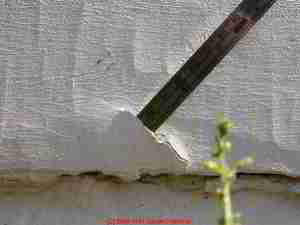
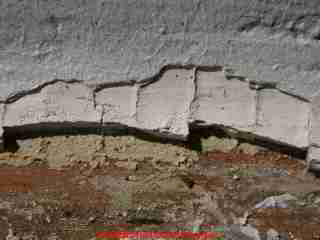
Paint Spalling failure is defined as flaking chipping of masonry surfaces. On painted masonry moisture may be entering the surface through cracks or holes (or other routes) and getting behind the paint.
Winter freeze-thaw cycles (obviously only in cold climates) cause the wet substrate to freeze, expand, and chip off.
We've also seen this defect on brick walls which were tuck-pointed using a mortar with too much portland cement.
Acrylic surface
conditioners (primers) can reduce this effect.
See SPALLING CONCRETE BLOCK WALLS & CHIMNEYS for more about the causes & cures of spalling on masonry surfaces
Paint Spotting, brown or other stains bleeding through new paint - "surfactant leaching" - can cause spotting, possibly from painting a cool or damp surface or painting in cool or cold conditions.
See http://www.mcphersonpainting.com/leaching.htm and
also http://www.mcphersonpainting.com/tannin.htm which cites tannin staining, when tannic acid, such as oils in pine knots or cedar bleed through new paint.
Also see RUSTING above.
Surfactant leaching paint failures & staining: diagnosis, causes, cures, prevention
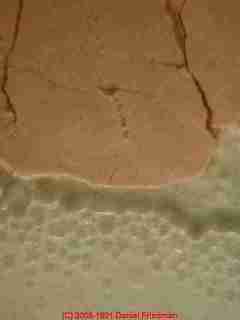 Surfactants are chemicals added to paints to improve paint flow
and or to aid in formation of an emulsion.
Surfactants are chemicals added to paints to improve paint flow
and or to aid in formation of an emulsion.
Surfactant leaching failures show up at a paint job as either a paint adhesion failure - paint is peeling or falling or cracking off of the surface (photo at left), or as Sherwin Williams puts it, you may see tan, brown, or clear spots or areas in the painted surface. These surfactant leach-areas may appear as glossy, soapy, oily, or sticky sections of the painted surface.
Causes of Surfactant Leaching or contributions to the effects of surfactant leaching
As I stated above at "incompatible paints", surfactant leaching can occur, for example, if there is an incompatibility between the primer coat and the finish coat. Paint chemists formulate primers and topcoats to work together as a tested and proven paint coating system.
Surfactant leaching also occurs when paints are applied in damp, wet, or cold weather or when other conditions show the drying or curing time for the paint job.
- Paint exposed to cool or cold temperatures before the paint has adequately dried. Cool temperatures slow the drying or "curing" of the paint job. In turn the long dry time resulting can allow surfactants to separate out from the paint - shown in our lab photograph at left.
- Paint exposed to moisture, dew, rain, high humidity before it has adequately dried - particularly pertinent to latex paints. All latex paints include some surfactants or it would not be possible to spread the paint onto its receiving surface.
Cures for Surfactant Leaching Paint Job Failures
Avoid surfactant leaching failures by making sure that the surface to be painted is dry, and don't paint in cold or wet weather, nor should you paint in conditions under which the paint is likely to be exposed to dew or rain before it has fully dried and cured.
But once surfactant leaching stains have appeared, on an outdoor wall you have two different situations:
- If the surfactant leaching stains have appeared while the paint job is still quite new it may be possible to wash the leached surfactants off of the surface, then allow it to dry. Scrub the surface lightly - not so hard as to remove the paint coating itself.
- If the surfactant leaching stains have appeared days or weeks after the paint job, or if they appeared early but no one did anything to ameliorate the situation (as in our lab sample photo), then the surfactant that leached out will usually have hardened and will be difficult or impossible to remove without actual sanding.
The surface will need to be re-painted. Be sure additional coats of primer or paint are compatible with the paints already on the surface.
Research on surfactant leaching and effect of surfactants on paint adhesion
- Leman, Arthur A. "Paint, Architectural." Kirk-Othmer Encyclopedia of Chemical Technology (2000).
- Maor, Yonah. "Delamination of oil paints from acrylic grounds." (2008). Abstract: Many modern artists paint in oil or oil-modified alkyd paints over acrylic grounds. In some cases the oil based paints do not remain adhered to the ground.
In a set of composite samples of oil or alkyd paints, over acrylic grounds, naturally aged for nine years, some of the samples delaminated. Samples were analyzed ... in order to find what the delaminating ones have in common.
In addition, two examples of severely delaminating paintings were examined, to confirm the results from the laboratory-prepared samples. Results indicate the main cause of delamination is metal soaps in the oil paint and particularly zinc soaps.
There is some evidence that metal soaps were more concentrated at the interface between the layers and this disrupted the adhesion. The ground is a minor consideration as well, rougher grounds providing better adhesion than smooth ones. - Maor, Yonah, and Alison Murray. "Delamination of Oil Paints on Acrylic Grounds." In MRS Proceedings, vol. 1047, pp. 1047-Y04. Cambridge University Press, 2007. Abstract In a set of composite samples of oil or alkyd paints, over acrylic grounds, naturally aged for eight years, some of the samples delaminated.
Samples were analyzed with X-ray fluorescence (XRF), inductively coupled plasma (ICP), Fourier transform infrared - attenuated total reflectance (FTIR-ATR) and atomic force microscopy (AFM) as well as other techniques not detailed in this paper.
Results indicate the main cause of delamination is metal soaps in the oil paint and particularly zinc soaps. The ground is a minor consideration as well, rougher grounds providing better adhesion than smooth ones. - de Meijer, Mari, and Johan Nienhuis. "Influence of internal stress and extensibility on the exterior durability of wood coatings." Progress in Organic Coatings 65, no. 4 (2009): 498-503.
- Nehdi, Moncef, and Jon Sumner. "Recycling waste latex paint in concrete." Cement and concrete research 33, no. 6 (2003): 857-863.
- Nicholson, John W. "Recent developments in understanding film-formation by latex paints." Pigment & resin technology 26, no. 3 (1997): 161-164.
- Philip, A., and P. E. Schweitzer. "Paint and coatings: applications and corrosion resistance." Corrosion Technology, Taylor&Francis 23 (2005): 672.
- Schultz, Tor P., Darrel D. Nicholas, and Patti Lebow. "Discussion on Prior Commercial Wood Preservation Systems That Performed Less Well Than Expected." In Series: Conference Proceedings. 2014.ons and corrosion resistance. CRC Press, 2005.
- Sherwin Williams, "Surfactant Leaching", Sherwin Williams Paint Co., 1-800-474-3794, Website: http://www.sherwin-williams.com, retrieved 19 Aug 2015, original source: https://www.sherwin-williams.com/homeowners/ask-sherwin-williams/problem-solver/dirt-stain-discoloration/sw-article-dir-surfactant.html, Excerpts from Sherwin Williams' explanation of surfactant leaching paint failures:
Concentration of water-soluble paint ingredients called “surfactants” on the surface of a latex paint. May be evident as tan, brown, or clear spots or areas, and can sometimes be glossy, soapy, oily, or sticky.
Stain Bleed-Through paint failures: on paint jobs: proper cleaning & preparation are needed to remove black stains, algae, mold, or other contaminants before painting or staining wood or other surfaces; otherwise you can expect to see stain bleed-through the new coating of stain or paint on the wood surface.
See SIDING, WOOD CLEANERS, STAINS, PAINTS for preparing an exterior wood surface for staining or painting.
Also
see CONCRETE STAINS: ID & REMOVAL for building exteriors.
Before painting or staining a building exterior see
STAIN DIAGNOSIS on BUILDING EXTERIORS - knowing the cause of a stain and what it's made of guides stain removal & stain prevention
Interior stains will also bleed through paints and other coatings on walls, trim, cabinets, foundation walls if the surfaces are not properly cleaned and prepared.
To prevent stain-bleed-through on building interior surfaces start by proper diagnosis of the stain cause since some "stains" such as thermal tracking have nothing to do with failures of the paint coating. We may use a simple lacquer primer/sealer to prevent grease or paint bleed-through staining of a new paint job but first
see STAIN DIAGNOSIS on BUILDING INTERIORS to accurately understand the cause, and thus the prevention of stains on indoor surfaces.
To understand soot or dust deposition stains that recur even on good paint jobs,
see THERMAL TRACKING BRIDGING GHOSTING
For suggestions when cleaning & painting over mold or "mildew"
see FUNGICIDAL SEALANT USE GUIDE
Tackiness and slow-dry paint problems - are caused by painting a second coat too soon, or painting in wet or foggy weather, or applying paint onto a damp surface. If using an alkyd, painting in an enclosed, un-vented area the painter can also cause this condition.
Thickness of paint failures of painted surfaces: paint can build up to an excessive thickness, leading to cracking and peeling when a new coat is applied, as the under-coats have lost elasticity, or trap moisture or debris between paint layers.
Thinner or Excessive Solvent in paint - can cause paint failures including translucent rather than opaque coatings, poor paint adhesion, early paint weathering, paint peeling. Simply failure to mix the paint thinner, pigment, and binder adequately can cause these failures as can attempts to extend the paint by adding excessive amounts of thinner.
I hate to bring it up, but adding an incompatible thinner will of course ruin any paint and the paint job of the dope who tried spreading that glop onto a surface.
Also see MIXING PROBLEMS in PAINT
Paint - Vinyl siding paint failures - warping is caused by painting a light colored siding with dark paint, (overheating in sun exposure), probably aggravated by improper siding installation (nailed too tightly to the wall).
Some paints are formulated specifically to adhere to vinyl siding but may still peel if the siding was painted while wet or dirty. We've also seen plastic trim become deformed on metal entry doors which were painted a dark color, enclosed by a glass-storm door, and facing sunlight.
Paint Water Blisters - caused on interior surfaces by leaks into the building structure or on occasion by exterior wind-blown rain or leaks behind paint on exterior walls.
Photos, below, contributed by reader anonymous who described leaks behind interior paint in an arizona home.
We warned the occupant that leaks capable of producing water blisters behind interior paint also mean that there is a risk of hidden water damage or mold contamination
. In Arizona where this water-based paint blistering was observed we'd have been looking for a roof leak or an air conditioner or swamp cooler leak above this area.
[Click to enlarge any image]
Also see
Water Blisters (also called moisture blisters) are bubble-like deformation of paint films (Fig. 16–21). As the name implies, these blisters usually contain water when they form.
Photo: water blisters under exterior paint, US FPL, cited below.
Water blisters form between the wood substrate and the first coat of paint. After the blisters appear, they may dry out and collapse.
Small blisters may disappear completely and large ones may leave rough spots; in severe cases, the paint peels. Oil-alkyd paint recently applied to wet wood is most likely to blister. Old paint films are too rigid to swell and form blisters; they usually crack and peel.
Water blisters are not common on latex paint systems. Minimizing water absorption into wood is the only way to prevent water blisters. Water blisters may occur on siding and trim where rain enters through improperly flashed doors, windows, and vents; they are common near unsealed end grain of siding and trim.
Water from ice dams and overflow from blocked gutters can also cause water blisters.
Movement of water vapor from the inside of a structure to siding and trim may also cause water blisters. Plumbing leaks, humidifiers, and shower spray are sources of inside water. Minimizing water absorption also prevents decay (rot), warping, and checking of wood.
- (Wood Handbook US FPL (2010) p 16-26)
Above: weather-worn paint on a church in Clintondale, New York in 2021.
Paint Weathering - OPINION: The term "weathering paint" as used by lay persons, is a bit vague as weathering should properly be considered the normal aging of paint on a surface.
Surface weathering before paint is applied has in turn a significant effect on the durability of the paint job, so some paint failures may be due to pre-paint-job weathering (Williams 1987) while other paint conditions may be attributed to the anticipated on "normal" effects of weather on the painted surface.
In addition, the effects of pre- and post- paint job weathering vary significantly depending on the surface to be painted, for example wood vs. rusted steel.
Even if we restrict our paint weathering discussion to wood, the effects of pre and post weather exposure are significant variables and further, the wood species, dryness, density, and summer vs. winter wood bands all affect the life of the paint coating when exposed to weather.
In a paint job what's "normal" wear and what's not? Exposure to sun (or indoors perhaps artificial light), wind, rain, including acid rain (Schulz 2000), snow, ice, even dirt and vibration from nearby traffic, temperature variations, abrasion from blowing debris, rubbing branches & shrubs, exposure to airborne pollutants, and other factors all are components of normal weathering forces that affect a painted or coated surface.
One could discuss weathering and "aging" together, indicating typical, normal conditions such as cracking and chalking and even peeling, for each type of coating on each type of surface under each of a collection of typical environments.
A paint manufacturer who gives a warranted or anticipated life for their paint coating is making some assumptions about the typical weathering effects to which their coating will be exposed and how long it should endure.
In this list of paint failure categories, chalking, cracking, alligatoring, and fading are examples I'd consider "weathering" that might be normal or not, depending on factors we could list such as age, surface, exposure conditions.
I'm nervous about opening an escape clause for bad paint products and bad paint jobs that'll be called "normal weathering".
Paint failure categories in this master list such as solvent blisters, other blisters, peeling, are too often attributable to selection, preparation, mixing, application snafus. I would be sorry to see those show up as blamed on "normal weathering". What's the relationship between environment (longitude, sun, rain, acid rain, etc) and weathering. Is blistering ever acceptable? When is chalking normal and when does it indicate a defective product or an over-thinned paint?
Photo above: worn-out paint on a 1926 bungalo, courtesy of InspectApedia reader Gretchen
Paint Weathering Research References
Photo below: "weathering" paint failures on buildings or furniture like this blue chair, outdoors, exposed to intense sunlight in Guanajuato, Mexico, has to include the effects of sunlight as well as occasional rain.
- Creemers, J., M. De Meijer, Tanja Zimmermann, and Jürgen Sell. "Influence of climatic factors on the weathering of coated wood." European Journal of Wood and Wood Products 60, no. 6 (2002): 411-420.
- Gaylarde, C. C., L. H. G. Morton, K. Loh, and M. A. Shirakawa. "Biodeterioration of external architectural paint films–A review." International Biodeterioration & Biodegradation 65, no. 8 (2011): 1189-1198.
- Hunt, Fern Y., Michael A. Galler, and Jonathan W. Martin. "Microstructure of weathered paint and its relation to gloss loss: Computer simulation and modeling." Journal of Coatings Technology 70, no. 880 (1998): 45-53.
- Jämsä, Saila, Pirjo Ahola, and Pertti Viitaniemi. "Long-term natural weathering of coated ThermoWood." Pigment & resin technology 29, no. 2 (2000): 68-74.
Abstract: Heat treatment reduces hygroscopicity and accompanying dimensional changes in wood. Prior to coating, pine and spruce boards were heat treated at 225°C for six hours under steam, in order to achieve dimensional stability and durability of wood substrate. The panels were coated surface finishes which are commonly used on exterior cladding, joinery and fences in Finland. Performance of the coated heat‐treated and untreated panels was monitored during five years’ outdoor exposure.
Without coating the heat‐treated wood is not weather resistant. The original dark brown colour of the uncoated heat‐treated wood panels was not stable when exposed to weather, turning grey. Cracking of the heat‐treated wood without coating was at the same level as that of the untreated wood despite the lower moisture content of the heat‐treated wood. The unpigmented or low build stains and oils did not prevent cracking of the heat‐treated wood.
Weather resistance of the heat‐treated wood was improved by the water‐ or solvent‐borne paints. Wood heat treated by means of this process is comparable to untreated wood as a substrate for coatings and no alterations in coating recommendations are needed when considering coating of heat‐treated wood. - Mayne, J. E. O. "The problem of painting rusty steel." Journal of applied chemistry 9, no. 12 (1959): 673-680.
- Nichols, Mark E. "Anticipating paint cracking: the application of fracture mechanics to the study of paint weathering." Journal of Coatings Technology 74, no. 924 (2002): 39-46.
- Perrin, F. X., M. Irigoyen, E. Aragon, and J. L. Vernet. "Evaluation of accelerated weathering tests for three paint systems: a comparative study of their aging behaviour." Polymer degradation and stability 72, no. 1 (2001): 115-124.
- Schulz, U., P. Trubiroha, U. Schernau, and H. Baumgart. "The effects of acid rain on the appearance of automotive paint systems studied outdoors and in a new artificial weathering test." Progress in organic coatings 40, no. 1 (2000): 151-165.
- Williams, R. Sam, Jerrold E. Winandy, and William C. Feist. Paint adhesion to weathered wood. [PDF] Federation of Societies for Coatings Technology, Vol. 59, No. 749, June 1987. Retrieved 2016/06/20, original source: http://s3.amazonaws.com/academia.edu.documents
Abstract: Short-term outdoor exposure of western red cedar (WRC, Thuja plicata) prior to painting drastically decreased adhesion of primers. Freshly planed and unpainted WRC boards were exposed outdoors vertically facing south near Madison, Wl, for 1, 2, 4, 8, or 16 weeks during the late spring and summer of 1984. Following this weathering, the boards were painted with alkyd-oil or acrylic latex primers and, after curing for three months, tested in shear or tension to determine paint adhesion.
Specimens weathered for more than four weeks before painting failed primarily at the wood/paint interface while those weathered for four weeks failed either at the wood/paint interface or cohesively in the wood. The un weathered controls and boards weathered for two weeks or less failed primarily in the wood. The mean tensile strength of the paint/wood bond dropped 50% from approximately 300 psi (2,070 kPa) on wood weathered for four weeks to 150 psi (1,035 kPa) on wood weathered for 16 weeks.
Shear strength dropped 33% from approximately 750 psi (5,170 kPa) to 500 psi (3,450 kPa) after similar weathering periods. The primer/ wood bond strength of specimens weathered for two weeks or less is higher than the wood strength; therefore, the 50% decrease in tensile and 33% decrease in shear strengths indicate only part of the loss in paint adhesion.
Conclusions Excerpt: Adhesion of both an acrylic latex and an alkyd-oil primer to wood is significantly reduced after the wood substrate has weathered for four or more weeks before painting. These results were observed when evaluating exterior wood finishes in southern Wisconsin.
A greater effect in warmer and, especially. sunnier climates could be anticipated. Reduced paint adhesion and increased wood/paint interface failure will undoubtedly result in poor long-term paint and finish performance on wood specimens weathered four or more weeks before finishing.
Because of this, it is strongly recommended that any unprotected wood not be allowed to weather outdoors for more than two weeks before it is protected with some finish that will prevent photo degradation and water damage. This recommendation is based on the observation that there was almost no wood/paint interface failure observed in wood specimens that were weathered for two weeks or less.
We are currently conducting long-term outdoor exposure studies on paint and other finishes on weathered western red cedar boards and Douglas-fir roughsawn plywood. The results of these long-term exposure studies will be described in future publications. - Williams, R. Sam, and William C. Feist. "Durability of paint or solid-color stain applied to pre weathered wood." Forest Products Journal 43, no. 1 (1993): 8.
Paint Wrinkling failure - wrinkles in the top paint layer may be caused if paint is applied too thickly, if the paint is not brushed out, or if paint is applied over a prior coating which has not dried.
Paint Yellowing failure - caused by lack of natural light, or alternatively by exposure to sunlight. Moisture, heat, or fumes (such as from oil or gas fired equipment) can also cause yellowing of some paints, as can some paint additives (such as "mildewcides").
...
Reader Comments, Questions & Answers About The Article Above
Below you will find questions and answers previously posted on this page at its page bottom reader comment box.
Reader Q&A - also see RECOMMENDED ARTICLES & FAQs
On 2017-03-30 by (mod) - White paint on a building exterior oxidizes and may develop an off-white hue
Anon
White paint on a building exterior oxidizes and may develop an off-white hue and also, depending on paint type may develop a chalky surface.
But when white exterior paint actually looks gray I suspect
- deposits of dirt or dust
- possibly mold or an algae if the gray area is blotchy, spotted, and correlates with shade, wetness, dampness
- exposed to soot or chimney or fire smoke
On 2017-03-29 by Anonymous
Why does white paint turn grey
On 2016-03-19 by (mod) -
Sounds as if the installer used nails that are rusting. You'll need to set nails and fill and re-seal the surface
On 2016-03-10 by Diane
Fairly new home, 3-4yrs, damp location, near ocean. High-end build, rough-sawn cedar trim used for posts and window trim. Painted white, galvanized nails. Every nail location is now black, about a 0.25in diameter. Can be washed off if rubbed hard.
Perhaps the nail was counter-sunk and puttied/filled. Slight cracking around putty/filler. About 15 "spots" per window frame. What can be done now to reduce maintenance in the future.
On 2015-11-02 by (mod) -
Yeah I hate that problem - I just had it while changing out a thermostat.
I would
1. cut around the edges of the bracket with a utility knife or drywall knife, scoring through the paint into the paper. This will at least minimize possible damage to the drywall when you pull the TV bracket off of the wall;
2. try prying carefully behind the bracket using a thin-bladed putty knife, working from all sides. If that's not long enough you can try a cake knife - or anything that is thin and flat.
3. Once you've loosened as much as you can pull away from one edge, lifting the bracket off of the wall; if despite your efforts some of the drywall paint and paper begin to tear, the tear should stop where you cut around the bracket edges: if it doesn't stop and cut a bit deeper.
4. With the bracket removed you'll have to use joint compound to fill any gouges in the wall and then re-paint.
Sorry but that's my best shot; I do not advise fooling with solvents: you're more likely to make a bigger mess on the wall - and that's before considering the health hazards.
On 2015-10-31 by Anonymous
A flat screen tv bracket was mounted to the wall prior to the paint fully drying- we assume-
What is the best method to remove the bracket without damaging the wall or paint-
FYI- it's been stuck to the wall for months with no tv, no screws or anything.
On 2015-10-01 by Anonymous
I just had a few exterior fiberglass doors painted and few weeks later mildew was present on every single door that 'twas repainted . My painter says the correct paint was used and that I would need to expect to do regular cleaning maintained because this is normal since I live on a lake.
On 2015-09-10 by (mod) -
Milind the ARTICLE INDEX given above includes articles on the causes of various types of paint failure
On 2015-09-10 by Milind
What could be reason
On 2015-07-16 by (mod)
Jo I think you asked this question on another of our pages - please avoid that as it doubles our work unnecessarily.
If your painter painted over plaster that was still wet or not adequately cured that could be the trouble.
On 2015-07-16 by jo
I have paint peeling from fresh two coat plaster walls. The plaster is a two coat skip troll over existing walls. Paint people say plaster is failing and plaster people say it wasn't prepped correctly. Where do I turn and who do I believe?
Question:
(Oct 21, 2011) fgh said:
acrylic resin separate from acrylic sctracth plaster
Reply:
Sounds as if there was either an improper mix or the scracth coat was wet or debris coated.
Question: Why does stucco turn yellow?
20 March 2015 Anon asked:
Why does stucco turn yellow?
Reply:
Anon
Are you asking about an un-painted surface? If so gray color would be more likely. Mostly deposition of airborne dust and debris; some photooxidation.
Traditional stucco is a cementious product that if not stained or painted will be gray.
Modern EIFS synthetic stucco systems are quite different in composition though many of those scratch and top coats are also gray coloured.
Painted surfaces change as the surface is oxidized.
Of course plenty of surface contaminants or uninvited guests also impart color, such as algae (though green or black not yellow) and even pollen (maybe yellow dust)
Question: brown stains leaching through wall surfaces and discolouring paint
(Mar 29, 2015) Anonymous said:
Brown stains are leaching through the drywall to the paint. Every room is covered with the stain which happened 6 years after originally paint. The stain can not be washed off with anything. What is it and what could have caused it?
Reply:
I don't have enough information to know a solid answer, and don't yet know if you are discussing an indoor or an exterior surface: but it certainly sounds as if there is bleed-through the paint, perhaps from a leak into the wall. Water leaking into a building wall or ceiling cavity will often pick up oils, tannins, or other materials from various building materials.
Question: paint fairly rusty metal I beams
(June 18, 2015) Renna said:
I have been contracted to paint fairly rusty metal I beams and a 45 degree angled top of a parapet wall. It is very hot and the metal temperatures are probably in excess of 110 degrees. Is there a product I can use in extremely hot weather.
Researching I have found Gardner-Gibson Metal X and it seems to be rated well for this project. Can anyone provide any assistance?
Reply:
This may sound a bit glib, Renna, but the three steps to any successful paint job are prepare, prepare, prepare. If the surface to be painted does not provide a sound adhesion base for the primer and top coat the paint job will not be durable.
I am not aware of paints that advertise hot surface application on buildings, but certainly you will check the label of the paint you're going to try or buy. Conversely there are automotive paints and also flame-proof coatings intended for high temperature application such as spray paints for exhaust manifolds.
See the products from Ceramiweld and from VHTPaint as well as from Aremco.
Some high temperature black paints are among the wood and coal stove paint product lines.
...
Continue reading at PAINT FAILURE INDICATORS or select a topic from the closely-related articles below, or see the complete ARTICLE INDEX.
Or see these
Recommended Articles
- ARTWORK MOLD CONTAMINATION - mold on paintings or other works of art
- HARDBOARD MASONITE™ & OTHER BRANDS - includes HARDBOARD & MASONITE USED in WORKS OF ART
- LEAD POISONING HAZARDS GUIDE
- PAINT & STAIN LIFE CHART that gives typical life expectancies of building exterior coatings on different types of wood surfaces.
- PAINT & STAIN SELECTION & PROCEDURES
- PAINT FAILURE, DIAGNOSIS, CURE, PREVENTION - home
- PAINT FAILURE DICTIONARY - illustrated list of all types of paint failures
- PAINT FAILURE INDICATORS
- PAINTING MISTAKES
- PAINT SURFACE PREPARATION
- SIDING, WOOD CLEANERS, STAINS, PAINTS - how to remove stains on siding & how to choose the proper paint or stain coating - formulas for bleach solution used to clean wood siding or trim stain
Suggested citation for this web page
PAINT FAILURE DICTIONARY at InspectApedia.com - online encyclopedia of building & environmental inspection, testing, diagnosis, repair, & problem prevention advice.
Or see this
INDEX to RELATED ARTICLES: ARTICLE INDEX to PAINTS & STAINS & FAILURES
Or use the SEARCH BOX found below to Ask a Question or Search InspectApedia
Ask a Question or Search InspectApedia
Try the search box just below, or if you prefer, post a question or comment in the Comments box below and we will respond promptly.
Search the InspectApedia website
Note: appearance of your Comment below may be delayed: if your comment contains an image, photograph, web link, or text that looks to the software as if it might be a web link, your posting will appear after it has been approved by a moderator. Apologies for the delay.
Only one image can be added per comment but you can post as many comments, and therefore images, as you like.
You will not receive a notification when a response to your question has been posted.
Please bookmark this page to make it easy for you to check back for our response.
IF above you see "Comment Form is loading comments..." then COMMENT BOX - countable.ca / bawkbox.com IS NOT WORKING.
In any case you are welcome to send an email directly to us at InspectApedia.com at editor@inspectApedia.com
We'll reply to you directly. Please help us help you by noting, in your email, the URL of the InspectApedia page where you wanted to comment.
Citations & References
In addition to any citations in the article above, a full list is available on request.
- Karlson, L., F. Joabsson, and K. Thuresson. "Phase behavior and rheology in water and in model paint formulations thickened with HM-EHEC: influence of the chemical structure and the distribution of hydrophobic tails." Carbohydrate polymers 41, no. 1 (2000): 25-35.
- Nichols, M. E., J. L. Gerlock, C. A. Smith, and C. A. Darr. "The effects of weathering on the mechanical performance of automotive paint systems."Progress in Organic Coatings 35, no. 1 (1999): 153-159.
- Nichols, Mark E. "Anticipating paint cracking: the application of fracture mechanics to the study of paint weathering." Journal of Coatings Technology74, no. 924 (2002): 39-46.
- Some of the topics discussed in this article are paraphrased and occasionally quoted from http://www.paint-worx.com/PaintFailure.htm and additions from http://www.bennette.com/pdf/whyfail.pdf.
- Lambourne, Ronald, and T. A. Strivens, eds. Paint and surface coatings: theory and practice. Elsevier, 1999. - see version cited just below.
- Paint and Surface Coatings, Theory and Practice, R. Lambourne & T.A. Strivens, Ed., Woodhead Publishing Ltd., William Andrew Publishing, 1999 ISBN 1-85573-348 X & 1-884207-73-1 [This is perhaps the leading reference on modern paints and coatings, but is a difficult text to obtain, and is a bit short on field investigation methods - DF]
- Analysis of Modern Paints, Thomas J.S. Learner, Research in Conservation, 2004 ISBN 0-89236-779-2 [Chemistry of modern paints, overview of analytical methods, pyrolysis-gas chromatography signatures of basic modern paints and their constituents, Fourier transform infrared spectroscopy for paint analysis, direct temperature-resolved mass spectrometry, and analysis in practice - technical reference useful for forensic paint science, focused on art works -DF]
- Seeing Through Paintings, Physical Examination in Art Historical Studies, Andrea Kirsh, Rustin S. Levenson, Materials in Fine Arts, 2000 ISBN 99-051835 [ forensic science, technical reference, focused on art works - DF]
- Sealants, Durability of Building Sealants (RILEM Proceedings), J.C. Beech, A.T. Wolf, Spon Press; illustrated edition (1995), ISBN-10: 0419210709, ISBN-13: 978-0419210702
This book presents the papers given at the RILEM Seminar held at the Building Research Establishment, Garston, UK in October 1994. The book provides an opportunity for researchers to review up-to-date progress towards the achievement of the objectives of the standardisation of laboratory techniques of sealants in the variety of service conditions to which they are exposed. - Soiling and Cleaning of Building Facades (RILEM Report), L.G.W. Verhoef (Editor), Routledge; 1 edition (November 3, 1988), ISBN-10: 0412306700, USBN-13: 978-0412306709
The report of a comprehensive investigation by RILEM which examines all aspects of the cleaning of facades, subject to soiling by both biological and non-biological agencies. The contributors are international authorities working in this field giving essential advice to all those who need to know how to approach the problems connected with the soiling and cleaning of building facades. - Staining, Prevention of Premature Staining in New buildings, Phil Parnham, Taylor & Francis; 1996, ISBN-10: 0419171304, ISBN-13: 978-0419171300
The appearance of ugly staining early in a buildings life, ruins an otherwise pleasing appearance, tarnishes the image of the owners and gives rise to costly refurbishment works. In this book Phil Parnham raises a number of questions that should be considered whenever a new building is being designed or built. These are: * why has staining become so prominent; * what causes premature staining; which parts of new buildings are likely to be affected; * how can it be avoided? By using a number of highly illustrated case studies, the author answers these questions and ends by suggesting measures that should be taken by all design and construction professionals to prevent premature staining. - Paint Handbook: testing, selection, application, troubleshooting, surface preparation, etc., Guy E. Weismantel, Ed., McGraw Hill Book Company, 1981, ISBN-10: 0070690618, ISBN-13: 978-0070690615, [Excellent but a bit obsolete paint theory and practice, also a bit light on field investigation methods, out of print, available used-DF]
How to select and apply the right paint or coating for any surface. The first major reference to help you choose the correct paint or other finish to do the job best on a particular surface exposed to a particular environment. Experts in the field give full advice on testing surface preparation, application, corrosion prevention, and troubleshooting. The handbook covers wood, metal, composites, and masonry, as well as marine applications and roof coatings. A ``must'' working tool for contractors, architects, engineers, specification writers, and paint dealers. - Paint and Surface Coatings, Theory and Practice, R. Lambourne & T.A. Strivens, Ed., Woodhead Publishing Ltd., William Andrew Publishing, 1999 ISBN 1-85573-348 X & 1-884207-73-1 [This is perhaps the leading reference on modern paints and coatings, but is a difficult text to obtain, and is a bit short on field investigation methods - DF]
Provides a comprehensive reference source for all those in the paint industry, paint manufacturers and raw materials suppliers, undergraduate and postgraduate students, and industrial paint users. R. Lambourne was in the Research Department at ICI Paints Division and the Industrial Colloid Advisory Group, Birstol University, UK. - Patton, T. C. "Fundamentals of paint rheology. J. Paint Technol. 1968."
- Art, Biology, and Conservation: Biodeterioration in Works of Art, Robert J. Koestler et als. Eds., Metropolitan Museum of Art, 2003, ISBN 1-58839-107-8
- Building Pathology, Deterioration, Diagnostics, and Intervention, Samuel Y. Harris, P.E., AIA, Esq., ISBN 0-471-33172-4, John Wiley & Sons, 2001 [General building science-DF - ** Particuarly useful text **
- Dampness in buildings, Diagnosis, Treatment, Instruments, T.A. Oxley & E.G. Gobert, ISBN 0-408-01463-6, Butterworths, 1983-1987 [General building science-DF]
- "Moisture Control in buildings: Putting Building Science in Green Building," Alex Wilson, Environmental Building News, Vol. 12. No. 5. [Good tutorial, "Moisture 101" outlining the physics of moisture movement in buildings and a good but incomplete list of general suggestions for moisture control - inadequate attention given to exterior conditions such as roof and surface drainage defects which are among the most-common sources of building moisture and water entry.--DJF]
- PAINT FAILURE PROBLEMS AND THEIR CURE [PDF] Daniel L. Cassens and William C. Feist, National Forest Products Laboratory
- WHY HOUSE PAINT FAILS, [PDF] Mark Knaebe, US FPL, web search August 2010, original source: http://www.fpl.fs.fed.us/documnts/finlines/knaeb95a.pdf
- WHY PAINT JOBS FAIL [on file as /exterior/Why_Paint_Fails_Bennett.pdf ] - , web search, August 2010, original source: http://www.bennette.com/pdf/whyfail.pdf, four pages describing alligatoring, bleeding, blistering, etc. Bennette Corporation, P.O. Box 9088, Hampton, VA 23670, Phone: 757-838-7777, Toll Free: 800-869-2929
Fax: 757-827-0529, Email: info@bennette.com, Website: www.bennette.com [Dead link 2019/12/13] quoting:
Bennette Paint Manufacturing Company, Inc. is a Virginia corporation which was founded in Newport News, Virginia in 1966 by James P. Bennette, Sr. In 1984, Mr Bennette sold the company to his employees through an Employee Stock Ownership Plan (ESOP). Today the company has a modern manufacturing plant, research laboratory, central warehouse and general offices located at 401 Industry Drive, Hampton, Virginia. ... Bennette Paint Manufacturing Company, Inc. also owns and operates Bennette Equipment Company which specializes in the sale, service, and rental of paint spraying and pressure cleaning equipment. - Supplemental Guidelines for Removing Paint From Interior and Exterior Wood Surfaces [on file as "/exterior/Paint_Removal_USGSA.pdf ] - , US General Services Administration, Historical Preservation Technical Procedures, 06400-02, web search August 2010, original source: //w3.gsa.gov/web/p/Hptp.nsf/0/40aff5a115b6a9e5852565c50054b4f4?OpenDocument
- "Common Paint Problems," parkerpaint.com/Common%20Paint%20Problems.htmlparkerpaint.com/Common%20Paint%20Problems.html illustrates common paint failures - though their images and text appear to have been stolen from PPG -whose own original page www.ppg.com/getpaint/etraining/solver/exterior.html was DOA as of 2019/12/13 which catalogs paint failures and causes
- "Paint problem solver" from Lowes unfortunately abandoned and removed from their site as of 2019/12/13
- MILL GLAZE, MYTH or REALITY [PDF], R. Sam Williams, Mark Knaebe, US FPL, retrieved 2019/12/13 original source: fpl.fs.fed.us/documnts/finlines/willi01a.pdf
- paintlab.com is a lab offering paint chip failure analysis
- PPG Exterior Failures http://www.ppg.com/getpaint/etraining/solver/exterior.html
- US FPL, WOOD HANDBOOK [PDF] U.S. Forest Products Laboratory, (2010) retrieved 2021/06/19 original source: https://www.fpl.fs.fed.us/documnts/fplgtr/fpl_gtr190.pdf
- Analysis of Modern Paints, Thomas J.S. Learner, Research in Conservation, 2004 ISBN 0-89236-779-2 [Chemistry of modern paints, overview of analytical methods, pyrolysis-gas chromatography signatures of basic modern paints and their constituents, Fourier transform infrared spectroscopy for paint analysis, direct temperature-resolved mass spectrometry, and analysis in practice - technical reference useful for forensic paint science, focused on art works -DF]
- Art, Biology, and Conservation: Biodeterioration in Works of Art, Robert J. Koestler et als. Eds., Metropolitan Museum of Art, 2003, ISBN 1-58839-107-8
- Building Pathology, Deterioration, Diagnostics, and Intervention, Samuel Y. Harris, P.E., AIA, Esq., ISBN 0-471-33172-4, John Wiley & Sons, 2001 [General building science-DF - ** Particularly useful text **
- Dampness in buildings, Diagnosis, Treatment, Instruments, T.A. Oxley & E.G. Gobert, ISBN 0-408-01463-6, Butterworths, 1983-1987 [General building science-DF]
- Paint and Surface Coatings, Theory and Practice, R. Lambourne & T.A. Strivens, Ed., Woodhead Publishing Ltd., William Andrew Publishing, 1999 ISBN 1-85573-348 X & 1-884207-73-1 [This is perhaps the leading reference on modern paints and coatings, but is a difficult text to obtain, and is a bit short on field investigation methods - DF]
- Paint Handbook: testing, selection, application, troubleshooting, surface preparation, etc., Guy E. Weismantel, Ed., McGraw Hill Book Company, 1981, ISBN-10: 0070690618, ISBN-13: 978-0070690615, [Excellent but a bit obsolete paint theory and practice, also a bit light on field investigation methods, out of print, available used-DF]
How to select and apply the right paint or coating for any surface. The first major reference to help you choose the correct paint or other finish to do the job best on a particular surface exposed to a particular environment. Experts in the field give full advice on testing surface preparation, application, corrosion prevention, and troubleshooting. The handbook covers wood, metal, composites, and masonry, as well as marine applications and roof coatings. A ``must'' working tool for contractors, architects, engineers, specification writers, and paint dealers. - Paint and Surface Coatings, Theory and Practice, R. Lambourne & T.A. Strivens, Ed., Woodhead Publishing Ltd., William Andrew Publishing, 1999 ISBN 1-85573-348 X & 1-884207-73-1 [This is perhaps the leading reference on modern paints and coatings, but is a difficult text to obtain, and is a bit short on field investigation methods - DF]
Provides a comprehensive reference source for all those in the paint industry, paint manufacturers and raw materials suppliers, undergraduate and postgraduate students, and industrial paint users. R. Lambourne was in the Research Department at ICI Paints Division and the Industrial Colloid Advisory Group, Birstol University, UK. - Seeing Through Paintings, Physical Examination in Art Historical Studies, Andrea Kirsh, Rustin S. Levenson, Materials in Fine Arts, 2000 ISBN 99-051835 [ forensic science, technical reference, focused on art works - DF]
- Sealants, Durability of Building Sealants (RILEM Proceedings), J.C. Beech, A.T. Wolf, Spon Press; illustrated edition (1995), ISBN-10: 0419210709, ISBN-13: 978-0419210702
This book presents the papers given at the RILEM Seminar held at the Building Research Establishment, Garston, UK in October 1994. The book provides an opportunity for researchers to review up-to-date progress towards the achievement of the objectives of the standardisation of laboratory techniques of sealants in the variety of service conditions to which they are exposed. - Soiling and Cleaning of Building Facades (RILEM Report), L.G.W. Verhoef (Editor), Routledge; 1 edition (November 3, 1988), ISBN-10: 0412306700, USBN-13: 978-0412306709
The report of a comprehensive investigation by RILEM which examines all aspects of the cleaning of facades, subject to soiling by both biological and non-biological agencies. The contributors are international authorities working in this field giving essential advice to all those who need to know how to approach the problems connected with the soiling and cleaning of building facades. - Staining, Prevention of Premature Staining in New buildings, Phil Parnham, Taylor & Francis; 1996, ISBN-10: 0419171304, ISBN-13: 978-0419171300
The appearance of ugly staining early in a buildings life, ruins an otherwise pleasing appearance, tarnishes the image of the owners and gives rise to costly refurbishment works. In this book Phil Parnham raises a number of questions that should be considered whenever a new building is being designed or built. These are: * why has staining become so prominent; * what causes premature staining; which parts of new buildings are likely to be affected; * how can it be avoided? By using a number of highly illustrated case studies, the author answers these questions and ends by suggesting measures that should be taken by all design and construction professionals to prevent premature staining. - "Moisture Control in buildings: Putting Building Science in Green Building," Alex Wilson, Environmental Building News, Vol. 12. No. 5. [Good tutorial, "Moisture 101" outlining the physics of moisture movement in buildings and a good but incomplete list of general suggestions for moisture control - inadequate attention given to exterior conditions such as roof and surface drainage defects which are among the most-common sources of building moisture and water entry.--DJF]
- Williams, R. Sam, Jerrold E. Winandy, and William C. Feist. Paint adhesion to weathered wood. Federation of Societies for Coatings Technology, 1987.
- In addition to citations & references found in this article, see the research citations given at the end of the related articles found at our suggested
CONTINUE READING or RECOMMENDED ARTICLES.
Paint & Fiber Forensic Analysis, Diagnosis, Conservation
- Analysis of Modern Paints, Thomas J.S. Learner, Research in Conservation, 2004 ISBN 0-89236-779-2
[Chemistry of modern paints, overview of analytical methods, pyrolysis-gas chromatography signatures of basic modern paints and their constituents, Fourier transform infrared spectroscopy for paint analysis, direct temperature-resolved mass spectrometry, and analysis in practice - technical reference useful for forensic paint science, focused on art works. One of our most useful texts in forensic investigation of paint failures and paint problem diagnosis - for building investigators as well as art conservators. -DF]
Although oil remains an important binding medium in artists' paints, today's synthetic resins are being used with increasing frequency. This was true during much of the twentieth century, when artists such as David Alfaro Siqueiros, Jackson Pollock, and Pablo Picasso used commercial or industrial paints based on synthetic resins. The growing popularity of synthetic resin materials carries important implications for the conservation, preservation, and treatment of modern art.
This volume outlines the techniques that are currently employed to analyze the synthetic resins used in modern painting materials, such as pyrolysis-gas chromatography-mass spectrometry, Fourier Transform infrared spectroscopy, and direct temperature-resolved mass spectrometry. For each technique, results are given for standard samples of the principal classes of synthetic binding media, various pigments and extenders, tube paint formulations, and microscopic paint fragments taken from actual works of art.
Primarily intended for conservation scientists, conservators, researchers, and students of conservation, this book will also be of interest to other museum professionals. - Art, Biology, and Conservation: Biodeterioration in Works of Art, Robert J. Koestler et als. Eds., Metropolitan Museum of Art, 2003, ISBN 1-58839-107-8
Series of excellent research and advice articles on art work conservation of special use to conservators and also to building, artifact, and art forensic investigators. MOMA. - DF
Despite the perception that artworks are timeless and unchanging, they are actually subject to biological attack from a variety of sources—from bacteria to fungi to insects. This groundbreaking volume, which publishes the proceedings of a conference held at The Metropolitan Museum of Art in 2002, explores how the development of these organisms can be arrested while preserving both the work of art and the health of the conservator.
The richly illustrated text, containing the writings of over 40 scientists and conservators, is divided into sections on stone and mural paintings, paper, textiles, wood and archaeological materials, treatment and prevention, and special topics. The artworks and cultural properties discussed include, among many others, Paleolithic cave paintings, Tiffany drawings, huts built by early Antarctic explorers, and a collection of toothbrushes taken from Auschwitz victims. -- Robert J. Koestler is a research scientist at The Metropolitan Museum of Art; Victoria H. Koestler is a freelance writer and editor; A. Elena Charola is a freelance conservation scientist; and Fernando E. Nieto-Fernandez is a biologist at Old Westbury College, New York. - Cultural Heritage and Aerobiology, Methods and Measurement Techniques for Biodeterioration Monitoring, Paolo Mandrioli, Guilia Caneva, and Cristina Sabbioni, Eds., Kluwer Academic Publishers, 2003 ISBN 1-4020-1622-0
This is a translated and revised edition of the original Italian version. This book is the first to give a general overview of the application of aerobiology (the science that studies the biological components of the atmosphere) to the conservation of our cultural heritage. Aerobiological monitoring makes it possible to estimate the risks of degradation of artefacts of historical or artistic importance by airborne microorganisms (airborne spores and vegetative structures) according to the types of materials forming the artefacts, to the conditions of the microclimate and to the type of environmental pollution, thus enabling the planning of preventive or reparative intervention. Among the book's main features are: + Aspects of the biodeterioration of different materials (paper, wood, fabrics, parchment, leather, stone, glass, metals, plastic, etc.). + Methods for measuring environmental parameters, both physical (microclimatic) and chemical (pollutants). + Methods and techniques of aerobiological monitoring. + Specific problems concerning the different types of environments. Audience: The subject is thoroughly explored, thus supplying a useful tool to those who are in charge of the conservation of our cultural heritage (libraries, archives, museums, churches, hypogea, monuments, archaeological sites, etc.).
See our book review of this reference. - Exterior Paint Problems on Historic Woodwork [Copy on file as /exterior/Preservation_Brief_10_ Exterior_Paint_Problems_on_Historic_Woodwork.pdf ] - , Kay D. Weeks and David W. Look, AIA, U.S. Department of the Interior, National Parks Service Preservation Brief No. 10. Web search 02/01/2011, original source: http://www.nps.gov/hps/tps/briefs/brief10.htm
- Microscopy of Textile Fibres (Microscopy Handbooks, 32), P H Greaves, Garland Science; 1 edition (January 1, 1995), ISBN-10: 1872748244, ISBN-13: 978-1872748245
[We ordered our copy from the British publisher - now it's on Amazon.
These 3 fiber books have been essential forensic lab references supplementing our McCrone Research courses on forensic microscopy; also of use to textile conservators. - DF
An up-to-date practical guide to the properties and characteristics of textile fibres, with clear advice on sampling, specimen preparation and examination procedures. - Microscopy of Animal Textile Fibres, Alex Blakey Wildm, 1954
Hard to obtain, useful for forensic microscopy - DF - Modern Paints Uncovered (Getty Conservation Institute Symposium Proceedings), Thomas Learner, Getty Publications (March 1, 2008),ISBN-10: 089236906X, ISBN-13: 978-0892369065
Over the past seventy years, a staggering array of new pigments and binders has been developed and used in the production of paint, and twentieth-century artists readily applied these materials to their canvases. Paints intended for houses, boats, cars, and other industrial applications frequently turn up in modern art collections, posing new challenges for paintings conservators.
This volume presents the papers and posters from "Modern Paints Uncovered," a symposium organized by the Getty Conservation Institute, Tate, and the National Gallery of Art and held at Tate Modern, London, in May 2006. Professionals from around the world shared the results of research on paints that have been available to artists since 1930--the date that synthetic materials began to significantly impact the paint industry.
Modern Paints Uncovered showcases the varied strands of cutting-edge research into the conservation of contemporary painted surfaces. These include paint properties and surface characteristics, analysis and identification - Of Microbes and Art: The Role of Microbial Communities in the Degradation and Protection of Cultural Heritage, Kindle Edition, Springer; 1 edition (June 30, 2000), ASIN: B000VHV4FC
- Paint Handbook: testing, selection, application, troubleshooting, surface preparation, etc., Guy E. Weismantel, Ed., McGraw Hill Book Company, 1981
[Excellent but a bit obsolete paint theory and practice, also a bit light on field investigation methods, out of print, available used. Very useful reference for paint testing, selection, and paint failure diagnosis - focus on non-artistic use of paints such as on buildings, roofs, marine coatings. -DF]
How to select and apply the right paint or coating for any surface. The first major reference to help you choose the correct paint or other finish to do the job best on a particular surface exposed to a particular environment. Experts in the field give full advice on testing surface preparation, application, corrosion prevention, and troubleshooting. The handbook covers wood, metal, composites, and masonry, as well as marine applications and roof coatings. A ``must'' working tool for contractors, architects, engineers, specification writers, and paint dealers - Paint Magic, Jocasta Innes, Frances Lincoln; 4th edition (August 17, 2006), ISBN-10: 071122272X, ISBN-13: 978-0711222724 - Paint advice for home decoration, including painting techniques such as antiquing, bambooing, bleaching, color washing, combing, decorative painting, dragging, dyeing, gliding, graining, japanning, lacquering, lining, marbling, porphyry, rag-rolling, sponging, staining, stencilling, stippling, tortoiseshelling, trompe l'oeil, and vinegar painting - DF
- Paint and Surface Coatings, Theory and Practice, R. Lambourne & T.A. Strivens, Ed., Woodhead Publishing Ltd., William Andrew Publishing, 1999 ISBN 1-85573-348 X & 1-884207-73-1
[ This is perhaps the leading reference on modern paints and coatings, but is a difficult text to obtain, and is a bit short on field investigation methods. Encyclopedic reference on the composition, production, properties, use, and testing of paints and coatings - DF]
Provides a comprehensive reference source for all those in the paint industry, paint manufacturers and raw materials suppliers, undergraduate and postgraduate students, and industrial paint users. - Plant Biology for Cultural Heritage: Biodeterioration and Conservation, Giulia Caneva, Maria Pia Nugari, Ornella Salvadori, Getty Publications (January 15, 2009), ISBN-10: 0892369396, ISBN-13: 978-0892369393
- Quality Assessment of Textile, Karl Marshall, Kindle Edition, Springer; 2nd edition (October 31, 1993, ASIN: B00193F3BI
The damage which can occur in certain fibrous raw materials or during the production and storage of textiles is expertly described in this book by Karl Mahall. He particularly shows how to find concealed textile defects by using microscopic analysis. The examples represent typical cases that the author encountered during forty years of experience in the industry. Well-illustrated with impressive photographs, they invite you to follow each step and learn to apply the same methodology in practice. This book is especially useful as a manual for both chemical and textile engineers and quality engineers. It is also a useful reference for others in the textile industry in general. - Dampness in buildings, Diagnosis, Treatment, Instruments, T.A. Oxley & E.G. Gobert, ISBN 0-408-01463-6, Butterworths, 1983-1987 [General building science-DF]
- "Moisture Control in buildings: Putting Building Science in Green Building," Alex Wilson, Environmental Building News, Vol. 12. No. 5. [Good tutorial, "Moisture 101" outlining the physics of moisture movement in buildings and a good but incomplete list of general suggestions for moisture control - inadequate attention given to exterior conditions such as roof and surface drainage defects which are among the most-common sources of building moisture and water entry.--DJF]
- PAINT FAILURE PROBLEMS AND THEIR CURE [PDF] Daniel L. Cassens and William C. Feist, National Forest Products Laboratory
- WHY HOUSE PAINT FAILS, [PDF] Mark Knaebe, US FPL, web search August 2010, original source: http://www.fpl.fs.fed.us/documnts/finlines/knaeb95a.pdf
- WHY PAINT JOBS FAIL [on file as /exterior/Why_Paint_Fails_Bennett.pdf ] - , web search, August 2010, original source: http://www.bennette.com/pdf/whyfail.pdf, four pages describing alligatoring, bleeding, blistering, etc. Bennette Corporation, P.O. Box 9088, Hampton, VA 23670, Phone: 757-838-7777, Toll Free: 800-869-2929
Fax: 757-827-0529, Email: info@bennette.com, Website: www.bennette.com [Dead link 2019/12/13] quoting:
Bennette Paint Manufacturing Company, Inc. is a Virginia corporation which was founded in Newport News, Virginia in 1966 by James P. Bennette, Sr. In 1984, Mr Bennette sold the company to his employees through an Employee Stock Ownership Plan (ESOP). Today the company has a modern manufacturing plant, research laboratory, central warehouse and general offices located at 401 Industry Drive, Hampton, Virginia. From these facilities the company is able to supply quality paints and coatings through its company owned distribution and service centers and authorized dealers located in Virginia, North Carolina and South Carolina. Bennette Paint Manufacturing Company, Inc. also owns and operates Bennette Equipment Company which specializes in the sale, service, and rental of paint spraying and pressure cleaning equipment. - Supplemental Guidelines for Removing Paint From Interior and Exterior Wood Surfaces [on file as "/exterior/Paint_Removal_USGSA.pdf ] - , US General Services Administration, Historical Preservation Technical Procedures, 06400-02, web search August 2010, original source: //w3.gsa.gov/web/p/Hptp.nsf/0/40aff5a115b6a9e5852565c50054b4f4?OpenDocument
- "Common Paint Problems," parkerpaint.com/Common%20Paint%20Problems.htmlparkerpaint.com/Common%20Paint%20Problems.html illustrates common paint failures - though their images and text appear to have been stolen from PPG -whose own original page www.ppg.com/getpaint/etraining/solver/exterior.html was DOA as of 2019/12/13 which catalogs paint failures and causes
- "Paint problem solver" from Lowes unfortunately abandoned and removed from their site as of 2019/12/13
- MILL GLAZE, MYTH or REALITY [PDF], R. Sam Williams, Mark Knaebe, US FPL, retrieved 2019/12/13 original source: fpl.fs.fed.us/documnts/finlines/willi01a.pdf
- paintlab.com is a lab offering paint chip failure analysis
- PPG Exterior Failures http://www.ppg.com/getpaint/etraining/solver/exterior.html
- "Peeling Back Paint Layers For a Glimpse Into the Past," James Barron, The New York Times, 25 Feb 2010, p. A26
- [2]Runeberg, Ulrik, STAINING AND MICROBIOLOGICAL INFESTATION OF ACRYLIC PAINTINGS ON HARDBOARD [PDF] (2008),Conservator (Dipl. Rest./M.A.), Restaurierungszentrum der Landeshauptstadt Düsseldorf, Germany, Email: Rune-Ulrik@gmx.de Previously Museo de Arte Contemporáneo de Puerto Rico, San Juan Presented, April 2007 conference in Richmond Virginia, sponsored by the AIC (American Institute for Conservation), this paper discusses the staining and microbial infestation of acrylic paintings on hardboard. - private correspondence, ER <->DF 2020/01/05 - 2006/09/12. (Also see PAINT FALURE, DIAGNOSIS, CURE, PREVENTION)
- In addition to citations & references found in this article, see the research citations given at the end of the related articles found at our suggested
CONTINUE READING or RECOMMENDED ARTICLES.
- Carson, Dunlop & Associates Ltd., 120 Carlton Street Suite 407, Toronto ON M5A 4K2. Tel: (416) 964-9415 1-800-268-7070 Email: info@carsondunlop.com. Alan Carson is a past president of ASHI, the American Society of Home Inspectors.
Thanks to Alan Carson and Bob Dunlop, for permission for InspectAPedia to use text excerpts from The HOME REFERENCE BOOK - the Encyclopedia of Homes and to use illustrations from The ILLUSTRATED HOME .
Carson Dunlop Associates provides extensive home inspection education and report writing material. In gratitude we provide links to tsome Carson Dunlop Associates products and services.


